Recent Progress of Nanogenerators for Green Energy Harvesting: Performance, Applications, and Challenges
Abstract
:1. Introduction
2. Operation Principle
2.1. Vibration Energy
2.1.1. Piezoelectric Nanogenerators
2.1.2. Electromagnetic Nanogenerators
2.1.3. Triboelectricity Nanogenerators
2.1.4. Piezotronic Nanogenerators
2.2. Thermal Energy
Thermoelectric and Pyroelectric Nanogenerators
2.3. Hybrid Nanogenerators
3. Performance and Applications
4. Challenges and Perspectives
4.1. Design
4.2. Materials
4.3. Energy Storage and Electrical Interfaces
4.4. Fabrication
4.5. Reliability
5. Conclusions
Author Contributions
Funding
Institutional Review Board Statement
Informed Consent Statement
Data Availability Statement
Acknowledgments
Conflicts of Interest
References
- Keshavarz, R.; Shariati, N. Highly sensitive and compact quad-band ambient RF energy harvester. IEEE Trans. Ind. Electron. 2022, 69, 3609–3621. [Google Scholar] [CrossRef]
- Tao, K.; Chen, Z.; Yi, H.; Zhang, R.; Shen, Q.; Wu, J.; Tang, L.; Fan, K.; Fu, Y.; Miao, J.; et al. Hierarchical Honeycomb-Structured Electret/Triboelectric Nanogenerator for Biomechanical and Morphing Wing Energy Harvesting. Nano-Micro Lett. 2021, 13, 123. [Google Scholar] [CrossRef] [PubMed]
- Zhao, T.; Xu, M.; Xiao, X.; Ma, Y.; Li, Z.; Wang, Z.L. Recent progress in blue energy harvesting for powering distributed sensors in ocean. Nano Energy 2021, 88, 106199. [Google Scholar] [CrossRef]
- Tremmel, S.; Luo, X.; Rothammer, B.; Seynstahl, A.; Wang, B.; Rosenkranz, A.; Marian, M.; Zhu, L. Evaluation of DLC, MoS2, and Ti3C2Tx thin films for triboelectric nanogenerators. Nano Energy 2022, 97, 107185. [Google Scholar] [CrossRef]
- Niu, Q.; Wei, H.; Hsiao, B.S.; Zhang, Y. Biodegradable silk fibroin-based bio-piezoelectric/triboelectric nanogenerators as self-powered electronic devices. Nano Energy 2022, 96, 107101. [Google Scholar] [CrossRef]
- Lu, M.; Fu, G.; Osman, N.B.; Konbr, U. Green energy harvesting strategies on edge-based urban computing in sustainable internet of things. Sustain. Cities Soc. 2021, 75, 103349. [Google Scholar] [CrossRef]
- Gao, Y.; Liu, G.; Bu, T.; Liu, Y.; Qi, Y.; Xie, Y.; Xu, S.; Deng, W.; Yang, W.; Zhang, C. MXene based mechanically and electrically enhanced film for triboelectric nanogenerator. Nano Res. 2021, 14, 4833–4840. [Google Scholar] [CrossRef]
- Islam, E.; Abdullah, A.M.; Chowdhury, A.R.; Tasnim, F.; Martinez, M.; Olivares, C.; Lozano, K.; Uddin, M.J. Electromagnetic-triboelectric-hybrid energy tile for biomechanical green energy harvesting. Nano Energy 2020, 77, 105250. [Google Scholar] [CrossRef]
- Shaukat, R.A.; Saqib, Q.M.; Khan, M.U.; Chougale, M.Y.; Bae, J. Bio-waste sunflower husks powder based recycled triboelectric nanogenerator for energy harvesting. Energy Reports 2021, 7, 724–731. [Google Scholar] [CrossRef]
- Niu, Z.; Cheng, W.; Cao, M.; Wang, D.; Wang, Q.; Han, J.; Long, Y.; Han, G. Recent advances in cellulose-based flexible triboelectric nanogeneratorss. Nano Energy 2021, 87, 106175. [Google Scholar] [CrossRef]
- Nguyen, Q.-T.; Ahn, K.-K.K. Fluid-Based Triboelectric Nanogenerators: A Review of Current Status and Applications. Int. J. Precis. Eng. Manuf. Green Technol. 2021, 8, 1043–1060. [Google Scholar] [CrossRef]
- Sanad, M.F.; Shalan, A.E.; Abdellatif, S.O.; Serea, E.S.A.; Adly, M.S.; Ahsan, M. Thermoelectric Energy Harvesters: A Review of Recent Developments in Materials and Devices for Different Potential Applications. Top. Curr. Chem. (Z) 2020, 378, 48. [Google Scholar] [CrossRef] [PubMed]
- Karan, S.K.; Maiti, S.; Lee, J.H.; Mishra, Y.K.; Khatua, B.B.; Kim, J.K. Recent Advances in Self-Powered Tribo-/Piezoelectric Energy Harvesters: All-In-One Package for Future Smart Technologies. Adv. Funct. Mater. 2020, 30, 2004446. [Google Scholar] [CrossRef]
- Nie, W. A sliding hybrid triboelectric-electromagnetic nanogenerator with staggered electrodes for human motion posture. Energy Rep. 2022, 8, 617–625. [Google Scholar] [CrossRef]
- Sahu, M.; Hajra, S.; Panda, S.; Rajaitha, M.; Panigrahi, B.K.; Rubahn, H.-G.; Mishra, Y.K.; Kim, H.J. Waste textiles as the versatile triboelectric energy-harvesting platform for self-powered applications in sports and athletics. Nano Energy 2022, 97, 107208. [Google Scholar] [CrossRef]
- Pang, Y.; Zhu, X.; Lee, C.; Liu, S. Triboelectric nanogenerator as next-generation self-powered sensor for cooperative vehicle-infrastructure system. Nano Energy 2022, 97, 107219. [Google Scholar] [CrossRef]
- Bhatia, D.; Lee, K.-S.; Niazi, M.U.K.; Park, H.-S. Triboelectric nanogenerator integrated origami gravity support device for shoulder rehabilitation using exercise gaming. Nano Energy 2022, 97, 107179. [Google Scholar] [CrossRef]
- Fang, L.; Zheng, Q.; Hou, W.; Zheng, L.; Li, H. A self-powered vibration sensor based on the coupling of triboelectric nanogenerator and electromagnetic generator. Nano Energy 2022, 97, 107164. [Google Scholar] [CrossRef]
- Shi, S.; Jiang, Y.; Xu, Q.; Zhang, J.; Zhang, Y.; Li, J.; Xie, Y.; Cao, Z.-P. A self-powered triboelectric multi-information motion monitoring sensor and its application in wireless real-time control. Nano Energy 2022, 97, 107150. [Google Scholar] [CrossRef]
- Miskovsky, N.M.; Cutler, P.H.; Mayer, A.; Weiss, B.L.; Willis, B.; Sullivan, T.E.; Lerner, P.B. Nanoscale devices for rectification of high frequency Radiation from the infrared through the visible: A new approach. J. Nanotech. 2012, 2012, 512379. [Google Scholar] [CrossRef] [Green Version]
- Donchev, E.; Pang, J.S.; Gammon, P.M.; Centeno, A.; Xie, F.; Petrov, P.K.; Breeze, J.D.; Ryan, M.P.; Riley, D.J.; Alford, N. The rectenna device: From theory to practice (a review). MRS Energy Sustain. 2014, 1, E1. [Google Scholar] [CrossRef] [Green Version]
- Mupparapu, R.; Cunha, J.; Tantussi, F.; Jacassi, A.; Summerer, L.; Patrini, M.; Giugni, A.; Maserati, L.; Alabastri, A.; Garoli, D.; et al. High-Frequency Light Rectification by Nanoscale Plasmonic Conical Antenna in Point-Contact-Insulator-Metal Architecture. Adv. Energy Mater. 2022, 12, 2103785. [Google Scholar] [CrossRef]
- Shanawani, M.; Masotti, D.; Costanzo, A. THz Rectennas and Their Design Rules. Electronics 2017, 6, 99. [Google Scholar] [CrossRef] [Green Version]
- Byrnes, S.J.; Blanchard, R.; Capasso, F. Harvesting renewable energy from Earth’s mid-infrared emissions. Proc. Natl. Acad. Sci. USA 2014, 111, 3927–3932. [Google Scholar] [CrossRef] [PubMed] [Green Version]
- Joshi, S.; Moddel, G. Rectennas at optical frequencies: How to analyze the response. J. Applied Phys. 2015, 118, 084503. [Google Scholar] [CrossRef] [Green Version]
- Zhao, J.; Cong, Z.; Hu, J.; Lu, H.; Wang, L.; Wang, H.; Malyi, O.I.; Pu, X.; Zhang, Y.; Shao, H.; et al. Regulating zinc electroplating chemistry to achieve high energy coaxial fiber Zn ion supercapacitor for self-powered textile-based monitoring system. Nano Energy 2022, 93, 106893. [Google Scholar] [CrossRef]
- Zhang, Y.; Gao, X.; Zhang, Y.; Gui, J.; Sun, C.; Zheng, H.; Guo, S. High-efficiency self-charging power systems based on performance-enhanced hybrid nanogenerators and asymmetric supercapacitors for outdoor search and rescue. Nano Energy 2022, 92, 106788. [Google Scholar] [CrossRef]
- Yu, Z.; Zhang, Y.; Wang, Y.; Zheng, J.; Fu, Y.; Chen, D.; Wang, G.; Cui, J.; Yu, S.; Zheng, L.; et al. Integrated piezo-tribo hybrid acoustic-driven nanogenerator based on porous MWCNTs/PVDF-TrFE aerogel bulk with embedded PDMS tympanum structure for broadband sound energy harvesting. Nano Energy 2022, 97, 107205. [Google Scholar] [CrossRef]
- Li, R.; Wei, X.; Shi, Y.; Yuan, Z.; Wang, B.; Xu, J.; Wang, L.; Wu, Z.; Wang, Z.L. Low-grade heat energy harvesting system based on the shape memory effect and hybrid triboelectric-electromagnetic nanogenerator. Nano Energy 2022, 96, 107106. [Google Scholar] [CrossRef]
- Banerjee, S.; Bairagi, S.; Ali, S.W. A lead-free flexible piezoelectric-triboelectric hybrid nanogenerator composed of uniquely designed PVDF/KNN-ZS nanofibrous web. Energy 2022, 244, 123102. [Google Scholar] [CrossRef]
- Song, C.; Xia, K.; Xu, Z. A self-supported structure hybrid triboelectric/piezoelectric nanogenerator for biomechanical energy harvesting and pressure sensing. Microelectron. Eng. 2022, 256, 111723. [Google Scholar] [CrossRef]
- Zhao, Z.; Dai, Y.; Dou, S.X.; Liang, J. Flexible nanogenerators for wearable electronic applications based on piezoelectric materials. Mater. Today Energy 2021, 20, 100690. [Google Scholar] [CrossRef]
- Hinchet, R.; Seung, W.; Kim, S.W. Recent Progress on Flexible Triboelectric Nanogenerators for SelfPowered Electronics. ChemSusChem 2015, 8, 2327–2344. [Google Scholar] [CrossRef]
- Quelen, A.; Morel, A.; Gasnier, P.; Grézaud, R.; Monfray, S.; Pillonnet, G. A 30nA quiescent 80nW-to-14mW power-range shock-optimized SECE-based piezoelectric harvesting interface with 420% harvested-energy improvement. In Proceedings of the 2018 IEEE International Solid-State Circuits Conference—(ISSCC), San Francisco, CA, USA, 11–15 February 2018; pp. 150–152. [Google Scholar] [CrossRef] [Green Version]
- Hehn, T.; Hagedorn, F.; Maurath, D.; Marinkovic, D.; Kuehne, I.; Frey, A.; Manoli, Y. A Fully Autonomous Integrated Interface Circuit for Piezoelectric Harvesters. IEEE J. Solid-State Circuits 2012, 47, 2185–2198. [Google Scholar] [CrossRef]
- Mahapatra, A.; Ajimsha, R.S.; Misra, P. Oxygen annealing induced enhancement in output characteristics of ZnO based flexible piezoelectric nanogenerators. J. Alloys Compd. 2022, 913, 165277. [Google Scholar] [CrossRef]
- Huang, X.; Wang, Y.; Zhang, X. Ultrarobust, hierarchically anisotropic structured piezoelectric nanogenerators for self-powered sensing. Nano Energy 2022, 99, 107379. [Google Scholar] [CrossRef]
- Veeralingam, S.; Bharti, D.K.; Badhulika, S. Lead-free PDMS/PPy based low-cost wearable piezoelectric nanogenerator for self-powered pulse pressure sensor application. Mater. Res. Bull. 2022, 151, 111815. [Google Scholar] [CrossRef]
- Sahu, M.; Hajra, S.; Jadhav, S.; Panigrahi, B.K.; Dubal, D.; Kim, H.J. Bio-waste composites for cost-effective self-powered breathing patterns monitoring: An insight into energy harvesting and storage properties. Sustain. Mater. Technol. 2022, 32, e00396. [Google Scholar] [CrossRef]
- Sarkar, L.; Sushma, M.V.; Yalagala, B.P.; Rengan, A.K.; Singh, S.G.; Vanjari, S.R.K. ZnO nanoparticles embedded silk fibroin-a piezoelectric composite for nanogenerator applications. Nanotechnology 2022, 33, 265403. [Google Scholar] [CrossRef]
- Pusty, M.; Shirage, P.M. Insights and perspectives on graphene-PVDF based nanocomposite materials for harvesting mechanical energy. J. Alloys Compd. 2022, 904, 164060. [Google Scholar] [CrossRef]
- Tan, P.; Xi, Y.; Chao, S.; Jiang, D.; Liu, Z.; Fan, Y.; Li, Z. An Artificial Intelligence-Enhanced Blood Pressure Monitor Wristband Based on Piezoelectric Nanogenerator. Biosensors 2022, 12, 234. [Google Scholar] [CrossRef] [PubMed]
- Mahmud, M.A.P.; Adhikary, P.; Zolfagharian, A.; Adams, S.; Kaynak, A.; Kouzani, A.Z. Advanced design, fabrication, and applications of 3D-printable piezoelectric nanogenerators. Electron. Mater. Lett. 2022, 18, 129–144. [Google Scholar] [CrossRef]
- Shi, S.; Pan, Z.; Cheng, Y.; Zhai, Y.; Zhang, Y.; Ding, X.; Liu, J.; Zhai, J.; Xu, J. Three-dimensional polypyrrole induced high-performance flexible piezoelectric nanogenerators for mechanical energy harvesting. Comp. Sci. Technol. 2022, 219, 109260. [Google Scholar] [CrossRef]
- Pan, Q.; Wang, B.; Zhang, L.; Li, Z.; Yang, Z. Whisk-inspired Motion Converter for Ocean Wave Energy Harvesting. IEEE/ASME Trans. Mechatron. 2022, 27, 1808–1811. [Google Scholar] [CrossRef]
- Wang, J.; Pan, L.; Guo, H.; Zhang, B.; Zhang, R.; Wu, Z.; Wu, C.; Yang, L.; Liao, R.; Wang, Z.L. Rational Structure Optimized Hybrid Nanogenerator for Highly Efficient Water Wave Energy Harvesting. Adv. Energy Mater. 2019, 9, 1802892. [Google Scholar] [CrossRef]
- Wu, Y.; Zeng, Q.; Tang, Q.; Liu, W.; Liu, G.; Zhang, Y.; Wu, J.; Hu, C.; Wang, X. A teeterboard-like hybrid nanogenerator for efficient harvesting of low-frequency ocean wave energy. Nano Energy 2020, 67, 104205. [Google Scholar] [CrossRef]
- Zhang, X.; Yang, Q.; Ji, P.; Wu, Z.; Li, Q.; Yang, H.; Li, X.; Zheng, G.; Xi, Y.; Wang, Z.L. Modeling of liquid-solid hydrodynamic water wave energy harvesting system based on triboelectric nanogenerator. Nano Energy 2022, 99, 107362. [Google Scholar] [CrossRef]
- Zaw, N.Y.W.; Yun, J.; Goh, T.S.; Kim, I.; Kim, Y.; Lee, J.S.; Kim, D. All-polymer waterproof triboelectric nanogenerator towards blue energy harvesting and self-powered human motion detection. Energy 2022, 247, 123422. [Google Scholar] [CrossRef]
- Zhou, H.; Dong, J.; Liu, H.; Zhu, L.; Xu, C.; He, X.; Zhang, S.; Song, Q. The coordination of displacement and conduction currents to boost the instantaneous power output of a water-tube triboelectric nanogenerator. Nano Energy 2022, 95, 107050. [Google Scholar] [CrossRef]
- Li, W.; Wan, L.; Lin, Y.; Liu, G.; Qu, H.; Wen, H.; Ding, J.; Ning, H.; Yao, H. Synchronous nanogenerator with intermittent sliding friction self-excitation for water wave energy harvesting. Nano Energy 2022, 95, 106994. [Google Scholar] [CrossRef]
- Zhang, Z.; Hu, Z.; Wang, Y.; Wang, Y.; Zhang, Q.; Liu, D.; Wang, H.; Xu, M. Multi-Tunnel Triboelectric Nanogenerator for Scavenging Mechanical Energy in Marine Floating Bodies. J. Mar. Sci. Eng. 2022, 10, 455. [Google Scholar] [CrossRef]
- Wang, X.; Shi, Y.; Yang, P.; Tao, X.; Li, S.; Lei, R.; Liu, Z.; Wang, Z.L.; Chen, X. Fish-Wearable Data Snooping Platform for Underwater Energy Harvesting and Fish Behavior Monitoring. Small 2022, 18, 2107232. [Google Scholar] [CrossRef] [PubMed]
- Xu, L.; Jiang, T.; Lin, P.; Shao, J.J.; He, C.; Zhong, W.; Chen, X.Y.; Wang, Z.L. Coupled Triboelectric Nanogenerator Networks for Efficient Water Wave Energy Harvesting. ACS Nano 2018, 12, 1849–1858. [Google Scholar] [CrossRef]
- Wen, H.; Yang, P.; Liu, G.; Xu, S.; Yao, H.; Li, W.; Qu, H.; Ding, J.; Li, J.; Wan, L. Flower-like triboelectric nanogenerator for blue energy harvesting with six degrees of freedom. Nano Energy 2022, 93, 106796. [Google Scholar] [CrossRef]
- Wang, A.; Chen, J.; Wang, L.; Han, J.; Su, W.; Li, A.; Liu, P.; Duan, L.; Xu, C.; Zeng, Z. Numerical analysis and experimental study of an ocean wave tetrahedral triboelectric nanogenerator. Appl. Energy 2022, 307, 118174. [Google Scholar] [CrossRef]
- Qu, Z.; Huang, M.; Chen, C.; An, Y.; Liu, H.; Zhang, Q.; Wang, X.; Liu, Y.; Yin, W.; Li, X. Spherical triboelectric nanogenerator based on eccentric structure for omnidirectional low frequency water wave energy harvesting. Adv. Funct. Mater. 2022, 32, 2202048. [Google Scholar] [CrossRef]
- Xu, S.; Liu, G.; Wang, J.; Wen, H.; Cao, S.; Yao, H.; Wan, L.; Wang, Z.L. Interaction between water wave and geometrical structures of floating triboelectric nanogenerators. Adv. Energy Mater. 2021, 12, 2103408. [Google Scholar] [CrossRef]
- Feng, Y.; Han, J.; Xu, M.; Liang, X.; Jiang, T.; Li, H.; Wang, Z.L. Blue energy for green hydrogen fuel: A self-powered electrochemical conversion driven by triboelectric nanogenerators. Adv. Energy Mater. 2021, 10, 1902467. [Google Scholar] [CrossRef]
- Zheng, F.; Sun, Y.; Wei, X.; Chen, J.; Yuan, Z.; Jin, X.; Tao, L.; Wu, Z. A hybridized water wave energy harvester with a swing magnetic structure toward intelligent fishing ground. Nano Energy 2021, 90, 106631. [Google Scholar] [CrossRef]
- Torres, F.G.; Troncoso, O.P.; De-la-Torre, G.E. Hydrogel-based triboelectric nanogenerators: Properties, performance, and applications. Int. J. Energy Res. 2022, 46, 5603–5624. [Google Scholar] [CrossRef]
- Chen, B.; Wang, Z.L. Toward a new era of sustainable energy: Advanced triboelectric nanogenerator for harvesting high entropy energy. Small 2022, in press. [Google Scholar] [CrossRef] [PubMed]
- Bukhari, M.U.; Khan, A.; Maqbool, K.Q.; Arshad, A.; Riaz, K.; Bermak, A. Waste to energy: Facile, low-cost and environment-friendly triboelectric nanogenerators using recycled plastic and electronic wastes for self-powered portable electronics. Energy Rep. 2022, 8, 1687–1695. [Google Scholar] [CrossRef]
- Zhang, J.; Hu, Y.; Lin, X.; Qian, X.; Zhang, L.; Zhou, J.; Lu, A. High-performance triboelectric nanogenerator based on chitin for mechanical-energy harvesting and self-powered sensing. Carbohydr. Polym. 2022, 291, 119586. [Google Scholar] [CrossRef] [PubMed]
- Gravesen, J.; Willatzen, M.; Shao, J.; Wang, Z.L. Energy optimization of a mirror-symmetric spherical triboelectric nanogenerator. Adv. Funct. Mater. 2022, 32, 2110516. [Google Scholar] [CrossRef]
- Wu, H.; Wang, J.; Wu, Z.; Kang, S.; Wei, X.; Wang, H.; Luo, H.; Yang, L.; Liao, R.; Wang, Z.L. Multi-parameter optimized triboelectric nanogenerator based self-powered sensor network for broadband aeolian vibration online-monitoring of transmission lines. Adv. Energy Mater. 2022, 12, 2103654. [Google Scholar] [CrossRef]
- Wang, J.; Jiang, Z.; Sun, W.; Xu, X.; Han, Q.; Chu, F. Yoyo-ball inspired triboelectric nanogenerators for harvesting biomechanical energy. Appl. Energy 2022, 308, 118322. [Google Scholar] [CrossRef]
- Mathew, A.A.; Vivekanandan, S. Design and Simulation of Single-Electrode Mode Triboelectric Nanogenerator-Based Pulse Sensor for Healthcare Applications Using COMSOL Multiphysics. Energy Technol. 2022, 10, 2101130. [Google Scholar] [CrossRef]
- Zheng, Z.; Xia, J.; Wang, B.; Guo, Y. Hierarchically designed nanocomposites for triboelectric nanogenerator toward biomechanical energy harvester and smart home system. Nano Energy 2022, 95, 107047. [Google Scholar] [CrossRef]
- Sun, Z.; Yang, W.; Chen, P.; Zhang, Y.; Wang, X.; Hu, Y. Effects of PDMS Base/Agent Ratios and Texture Sizes on the Electrical Performance of Triboelectric Nanogenerators. Adv. Mater. Interfaces 2022, 9, 2102139. [Google Scholar] [CrossRef]
- Jiang, C.; Lai, C.L.; Xu, B.; So, M.Y.; Li, Z. Fabric-rebound triboelectric nanogenerators with loops and layered structures for energy harvesting and intelligent wireless monitoring of human motions. Nano Energy 2022, 93, 106807. [Google Scholar] [CrossRef]
- Wang, Z.L. Triboelectric nanogenerators as new energy technology and self-powered sensors-principles, problems and perspectives. Faraday Discuss. 2014, 176, 447. [Google Scholar] [CrossRef] [PubMed]
- Wang, Z. Nanopiezotronics. Adv. Mater. 2007, 19, 889–892. [Google Scholar] [CrossRef]
- Wang, Z.L. Towards Self-Powered Nanosystems: From Nanogenerators to Nanopiezotronics. Adv. Funct. Mater. 2008, 18, 3553–3567. [Google Scholar] [CrossRef]
- Wang, Z.L. The new field of nanopiezotronics. Mater. Today 2007, 10, 20–28. [Google Scholar] [CrossRef]
- Yang, Y. Pyroelectric and Thermoelectric Nanogenerators. In Hybridized and Coupled Nanogenerators; Yang, Y., Ed.; Wiley-VCH GmbH: Weinheim, Germany, 2020. [Google Scholar] [CrossRef]
- Klochko, N.P.; Klepikova, K.S.; Kopach, V.R.; Tyukhov, I.I.; Starikov, V.V.; Sofronov, D.S.; Khrypunova, I.V.; Zhadan, D.O.; Petrushenko, S.I.; Dukarov, S.V.; et al. Development of semi-transparent ZnO/FTO solar thermoelectric nanogenerator for energy efficient glazing. Sol. Energy 2019, 184, 230–239. [Google Scholar] [CrossRef]
- Khoso, N.A.; Xu, G.; Xie, J.; Sun, T.; Wang, J. The fabrication of a graphene and conductive polymer nanocomposite-coated highly flexible and washable woven thermoelectric nanogenerator. Mater. Adv. 2021, 2, 3695–3704. [Google Scholar] [CrossRef]
- Khoso, N.A.; Ahmed, A.; Deb, H.; Tian, S.; Jiao, X.; Gong, X.Y.; Wang, J. Controlled template-free in-situ polymerization of PEDOT for enhanced thermoelectric performance on textile substrate. Org. Electron. 2019, 75, 105368. [Google Scholar] [CrossRef]
- Feng, R.; Tang, F.; Zhang, N.; Wang, X. Flexible, High-Power Density, Wearable Thermoelectric Nanogenerator and Self-Powered Temperature Sensor. ACS Appl. Mater. Interfaces 2019, 11, 42. [Google Scholar] [CrossRef]
- He, M.; Lin, Y.-J.; Chiu, C.M.; Yang, W.; Zhang, B.; Yun, D.; Xie, Y.; Lin, Z.H. A flexible photo-thermoelectric nanogenerator based on MoS2/PU photothermal layer for infrared light harvesting. Nano Energy 2018, 49, 588–595. [Google Scholar] [CrossRef]
- Fan, Z.; Zhang, Y.; Pan, L.; Ouyang, J.; Zhang, Q. Recent developments in flexible thermoelectrics: From materials to devices. Renew. Sust. Energ. Rev. 2021, 137, 110448. [Google Scholar] [CrossRef]
- Xie, Y.; Chou, T.M.; Yang, W.; He, M.; Zhao, Y.; Li, N.; Lin, Z.-H. Flexible thermoelectric nanogenerator based on the MoS2/graphene nanocomposite and its application for a self-powered temperature sensor. Semicond. Sci. Technol. 2017, 32, 044003. [Google Scholar] [CrossRef]
- Huang, X.-L.; Ao, D.-W.; Chen, T.-B.; Chen, Y.-X.; Li, F.; Chen, S.; Liang, G.-X.; Zhang, X.-H.; Zheng, Z.-H.; Fan, P. High performance copper selenide thermoelectric thin films for flexible thermoelectric application. Mater. Today Energy 2021, 21, 100743. [Google Scholar] [CrossRef]
- Xu, C.; Yang, S.; Li, P.; Wang, H.; Li, H.; Liu, Z. Wet-spun PEDOT:PSS/CNT composite fibers for wearable thermoelectric energy harvesting. Compos. Commun. 2022, 32, 101179. [Google Scholar] [CrossRef]
- Palaporn, D.; Mongkolthanaruk, W.; Tanusilp, S.-A.; Kurosaki, K.; Pinitsoontorn, S. A simple method for fabricating flexible thermoelectric nanocomposites based on bacterial cellulose nanofiber and Ag2Se. Appl. Phys. Lett. 2022, 120, 073901. [Google Scholar] [CrossRef]
- Zhang, X.; Shiu, B.-C.; Li, T.T.; Liu, X.; Ren, H.-T.; Wang, Y.; Lou, C.-W.; Lin, J.-H. Synergistic work of photo-thermoelectric and hydroelectric effects of hierarchical structure photo-thermoelectric textile for solar energy harvesting and solar steam generation simultaneously. Chem. Eng. J. 2021, 426, 131923. [Google Scholar] [CrossRef]
- Wang, Y.; Zhu, W.; Deng, Y.; Zhu, P.; Yu, Y.; Hu, S.; Zhang, R. High-sensitivity self-powered temperature/pressure sensor based on flexible Bi-Te thermoelectric film and porous microconed elastomer. J. Mater. Sci. Technol. 2022, 103, 1–7. [Google Scholar] [CrossRef]
- Yuan, J.F.; Zhu, R.; Li, G.Z. Self-Powered Electronic Skin with Multisensory Functions Based on Thermoelectric Conversion. Adv. Mater. Technol. 2020, 5, 2000419. [Google Scholar] [CrossRef]
- Wang, Y.; Zhu, W.; Deng, Y.; Fu, B.; Zhu, P.; Yu, Y.; Li, J.; Guo, J. Self-powered wearable pressure sensing system for continuous healthcare monitoring enabled by flexible thin-film thermoelectric generator. Nano Energy 2020, 73, 104773. [Google Scholar] [CrossRef]
- Gokana, M.R.; Wu, C.-M.; Motora, K.G.; Qi, J.Y.; Yen, W.-T. Effects of patterned electrode on near infrared light-triggered cesium tungsten bronze/poly(vinylidene)fluoride nanocomposite-based pyroelectric nanogenerator for energy harvesting. J. Power Sources 2022, 536, 231524. [Google Scholar] [CrossRef]
- Mistewicz, K. Pyroelectric Nanogenerator Based on an SbSI–TiO2 Nanocomposite. Sensors 2022, 22, 69. [Google Scholar] [CrossRef]
- Feng, Y.; Zhang, Y.; Wang, Y.; Wang, Z. Frequency response characteristics of pyroelectric effect in p-n junction UV detectors. Nano Energy 2018, 54, 429–436. [Google Scholar] [CrossRef]
- Korkmaz, S.; Kariper, İ.A. Pyroelectric nanogenerators (PyNGs) in converting thermal energy into electrical energy: Fundamentals and current status. Nano Energy 2021, 84, 105888. [Google Scholar] [CrossRef]
- Ali, I.; Hassan, G.; Shuja, A. Fabrication of self-healing hybrid nanogenerators based on polyurethane and ZnO for harvesting wind energy. J Mater. Sci. Mater. Electron. 2022, 33, 3982–3993. [Google Scholar] [CrossRef]
- Mahanty, B.; Ghosh, S.K.; Maity, K.; Roy, K.; Sarkar, S.; Mandal, D. All-fiber pyro- and piezo-electric nanogenerator for IoT based self-powered health-care monitoring. Mater. Adv. 2021, 2, 4370–4379. [Google Scholar] [CrossRef]
- Abbasipour, M.; Khajavi, R.; Yousefi, A.A.; Yazdanshenas, M.E.; Razaghian, F.; Akbarzadeh, A. Improving piezoelectric and pyroelectric properties of electrospun PVDF nanofibers using nanofillers for energy harvesting application. Polym. Adv. Technol. 2019, 30, 279–291. [Google Scholar] [CrossRef]
- Zhu, L.; Lin, P.; Chen, B.; Wang, L.; Chen, L.; Li, D.; Wang, Z.L. Piezo-phototronic and pyro-phototronic effects to enhance Cu(In, Ga)Se2 thin film solar cells. Nano Res. 2018, 11, 3877–3885. [Google Scholar] [CrossRef]
- Liu, X.; Liu, Y.; Cheng, T.; Gao, Y.; Yang, Z. A high performing piezoelectric and triboelectric nanogenerator based on a large deformation of the novel lantern-shaped structure. Nano Energy 2022, 92, 106699. [Google Scholar] [CrossRef]
- Wang, Z.; Liu, Z.; Zhao, G.; Zhang, Z.; Zhao, X.; Wan, X.; Zhang, Y.; Wang, Z.L.; Li, L. Stretchable Unsymmetrical Piezoelectric BaTiO3 Composite Hydrogel for Triboelectric Nanogenerators and Multimodal Sensors. ACS Nano 2022, 16, 1661–1670. [Google Scholar] [CrossRef]
- Hou, X.; Zhong, J.; Yang, C.; Yang, Y.; He, J.; Mu, J.; Geng, W.; Chou, X. A high-performance, single-electrode and stretchable piezo-triboelectric hybrid patch for omnidirectional biomechanical energy harvesting and motion monitoring. J. Mater. 2022, in press. [Google Scholar] [CrossRef]
- Joo, H.; Lee, K.Y.; Lee, J. Piezo/Triboelectric Effect Driven Self-Powered Gas Sensor for Environmental Sensor Networks. Energy Technol. 2022, 10, 2200113. [Google Scholar] [CrossRef]
- Negedu, S.D.; Tromer, R.; Gowda, C.C.; Woellner, C.F.; Olu, F.E.; Roy, A.K.; Pandey, P.; Galvao, D.S.; Ajayan, P.M.; Kumbhakar, P.; et al. Two-dimensional cobalt telluride as a piezo-tribogenerator. Nanoscale 2022, 14, 7788–7797. [Google Scholar] [CrossRef] [PubMed]
- Zhang, J.-H.; Zhou, Z.; Li, J.; Shen, B.; Zhu, T.; Gao, X.; Tao, R.; Guo, X.; Hu, X.; Shi, Y.; et al. Coupling Enhanced Performance of Triboelectric–Piezoelectric Hybrid Nanogenerator Based on Nanoporous Film of Poly(vinylidene fluoride)/BaTiO3 Composite Electrospun Fibers. ACS Mater. Lett. 2022, 4, 847–852. [Google Scholar] [CrossRef]
- Nazar, A.M.; Egbe, K.I.; Jiao, P. Hybrid Piezoelectric and Triboelectric Nanogenerators for Energy Harvesting and Walking Sensing. Energy Technol. 2022, 10, 2200063. [Google Scholar] [CrossRef]
- Du, M.; Cao, Y.; Qu, X.; Xue, J.; Zhang, W.; Pu, X.; Shi, B.; Li, Z. Hybrid Nanogenerator for Biomechanical Energy Harvesting, Motion State Detection, and Pulse Sensing. Adv. Mater. Technol. 2022, 7, 2101332. [Google Scholar] [CrossRef]
- Kao, F.-C.; Ho, H.-H.; Chiu, P.-Y.; Hsieh, M.-K.; Liao, J.-C.; Lai, P.-L.; Huang, Y.-F.; Dong, M.-Y.; Tsai, T.T.; Lin, Z.-H. Self-assisted wound healing using piezoelectric and triboelectric nanogenerators. Sci. Technol. Adv. Mater. 2022, 23, 1–16. [Google Scholar] [CrossRef]
- Manchi, P.; Graham, S.A.; Patnam, H.; Paranjape, M.V.; Yu, J.S. rGO-ZnSnO3 Nanostructure-Embedded Triboelectric Polymer-Based Hybridized Nanogenerators. Adv. Mater. Technol. 2022, in press. [Google Scholar] [CrossRef]
- Zhu, Y.; Sun, F.; Jia, C.; Zhao, T.; Mao, Y. A Stretchable and Self-Healing Hybrid Nano-Generator for Human Motion Monitoring. Nanomaterials 2022, 12, 104. [Google Scholar] [CrossRef]
- García-Casas, X.; Ghaffarinejad, A.; Aparicio, F.J.; Castillo-Seoane, J.; López-Santos, C.; Espinós, J.P.; Cotrino, J.; Sánchez-Valencia, J.R.; Barranco, A.; Borrás, A. Plasma engineering of microstructured piezo—Triboelectric hybrid nanogenerators for wide bandwidth vibration energy harvesting. Nano Energy 2022, 91, 106673. [Google Scholar] [CrossRef]
- Toroń, B.; Mistewicz, K.; Jesionek, M.; Kozioł, M.; Zubko, M.; Stróż, D. A new hybrid piezo/triboelectric SbSeI nanogenerator. Energy 2022, 238C, 122048. [Google Scholar] [CrossRef]
- Li, X.; Ji, D.; Yu, B.; Ghosh, R.; He, J.; Qin, X.; Ramakrishna, S. Boosting piezoelectric and triboelectric effects of PVDF nanofiber through carbon-coated piezoelectric nanoparticles for highly sensitive wearable sensors. Chem. Eng. J. 2021, 426, 130345. [Google Scholar] [CrossRef]
- Yang, Z.; Zhu, Z.; Chen, Z.; Liu, M.; Zhao, B.; Liu, Y.; Cheng, Z.; Wang, S.; Yang, W.; Yu, T. Recent Advances in Self-Powered Piezoelectric and Triboelectric Sensors: From Material and Structure Design to Frontier Applications of Artificial Intelligence. Sensors 2021, 21, 8422. [Google Scholar] [CrossRef] [PubMed]
- Yang, X.; Li, P.; Wu, B.; Li, H.; Zhou, G. A flexible piezoelectric-triboelectric hybrid nanogenerator in one structure with dual doping enhancement effects. Curr. Appl. Phys. 2021, 32, 50–58. [Google Scholar] [CrossRef]
- Lee, T.; Kim, I.; Kim, D. Flexible Hybrid Nanogenerator for Self-Powered Weather and Healthcare Monitoring Sensor. Adv. Electron. Mater. 2021, 7, 2100785. [Google Scholar] [CrossRef]
- Singh, H.H.; Khare, N. A ferroelectric nanocomposite-film-based device for harvesting energy from water droplets using both piezoelectric and triboelectric effects. Nanotechnology 2021, 32, 485406. [Google Scholar] [CrossRef]
- Hajra, S.; Padhan, A.M.; Sahu, M.; Alagarsamy, P.; Lee, K.; Kim, H.J. Lead-free flexible Bismuth Titanate-PDMS composites: A multifunctional colossal dielectric material for hybrid piezo-triboelectric nanogenerator to sustainably power portable electronics. Nano Energy 2021, 89A, 106316. [Google Scholar] [CrossRef]
- Gai, Y.; Bai, Y.; Cao, Y.; Wang, E.; Xue, J.; Qu, X.; Liu, Z.; Luo, D.; Li, Z. A Gyroscope Nanogenerator with Frequency Up-Conversion Effect for Fitness and Energy Harvesting. Small 2022, 18, 2108091. [Google Scholar] [CrossRef]
- Mu, J.; He, H.; Song, J.; He, J.; Hou, X.; Han, X.; Feng, C.; Zou, J.; Yu, J.; Chou, X. Functional structure enhanced synergistic sensing from triboelectric–electromagnetic hybrid nanogenerator for self-powered rotating speed monitoring. Energy Rep. 2022, 8, 5272–5283. [Google Scholar] [CrossRef]
- Wang, D.; Zhang, D.; Tang, M.; Zhang, H.; Chen, F.; Wang, T.; Li, Z.; Zhao, P. Rotating triboelectric-electromagnetic nanogenerator driven by tires for self-powered MXene-based flexible wearable electronics. Chem. Eng. J. 2022, 446, 136914. [Google Scholar] [CrossRef]
- Yu, D.; Sun, C.; Wang, K.; Yin, S.; Sun, L.; Chen, H.; Kong, F. A novel direct-driven triboelectric–electromagnetic hybridized wave energy converter for buoy power supply. Appl. Nanosci. 2022, 12, 1697–1711. [Google Scholar] [CrossRef]
- Cho, H.; Kim, I.; Park, J.; Kim, D. A waterwheel hybrid generator with disk triboelectric nanogenerator and electromagnetic generator as a power source for an electrocoagulation system. Nano Energy 2022, 95, 107048. [Google Scholar] [CrossRef]
- He, J.; Fan, X.; Zhao, D.; Cui, M.; Han, B.; Hou, X.; Chou, X. A high-efficient triboelectric-electromagnetic hybrid nanogenerator for vibration energy harvesting and wireless monitoring. Sci. China Inf. Sci. 2022, 65, 142401. [Google Scholar] [CrossRef]
- Hu, Y.; Wang, X.; Qin, Y.; Li, Z.; Wang, C.; Wu, H. A robust hybrid generator for harvesting vehicle suspension vibration energy from random road excitation. Appl. Energy 2022, 309, 118506. [Google Scholar] [CrossRef]
- Chen, Y.; Jie, Y.; Zhu, J.; Lu, Q.; Cheng, Y.; Cao, X.; Wang, Z.L. Hybridized triboelectric-electromagnetic nanogenerators and solar cell for energy harvesting and wireless power transmission. Nano Res. 2022, 15, 2069–2076. [Google Scholar] [CrossRef]
- Mu, J.; Zou, J.; Song, J.; He, J.; Hou, X.; Yu, J.; Han, X.; Feng, C.; He, H.; Chou, X. Hybrid enhancement effect of structural and material properties of the triboelectric generator on its performance in integrated energy harvester. Energy Convers. Manag. 2022, 254, 115151. [Google Scholar] [CrossRef]
- Kong, F.; Yin, S.; Sun, C.; Yang, C.; Chen, H.; Liu, H. Design and optimization of a maglev electromagnetic–triboelectric hybrid energy converter for supplying power to intelligent sensing equipment. Sustain. Energy Fuels 2022, 6, 800–814. [Google Scholar] [CrossRef]
- Hong, H.; Yang, X.; Cui, H.; Zheng, D.; Wen, H.; Huang, R.; Liu, L.; Duan, J.; Tang, Q. Self-powered seesaw structured spherical buoys based on a hybrid triboelectric–electromagnetic nanogenerator for sea surface wireless positioning. Energy Environ. Sci. 2022, 15, 621–632. [Google Scholar] [CrossRef]
- Li, X.; Gao, Q.; Cao, Y.; Yang, Y.; Liu, S.; Wang, Z.L. Tinghai Cheng. Optimization strategy of wind energy harvesting via triboelectric-electromagnetic flexible cooperation. Appl. Energy 2022, 307, 118311. [Google Scholar] [CrossRef]
- Xin, C.; Guo, H.; Shen, F.; Peng, Y.; Xie, S.; Li, Z.; Zhang, Q. A Hybrid Generator with Electromagnetic Transduction for Improving the Power Density of Triboelectric Nanogenerators and Scavenging Wind Energy. Adv. Mater. Technol. 2022, in press. [Google Scholar] [CrossRef]
- Zhao, T.; Niu, B.; Xie, G.; Hu, C.; Liu, B.; Xu, M.; Ma, Y. A High Output Triboelectric–Electromagnetic Hybrid Generator Based on In-Phase Parallel Connection. Adv. Mater. Technol. 2022, 7, 2101485. [Google Scholar] [CrossRef]
- Zhang, B.; Zhang, S.; Li, W.; Gao, Q.; Zhao, D.; Wang, Z.L.; Cheng, T. Self-Powered Sensing for Smart Agriculture by Electromagnetic–Triboelectric Hybrid Generator. ACS Nano 2021, 15, 20278–20286. [Google Scholar] [CrossRef]
- Askari, H.; Xu, N.; Barbosa, B.H.G.; Huang, Y.; Chen, L.; Khajepour, A.; Chen, H.; Wang, Z.L. Intelligent systems using triboelectric, piezoelectric, and pyroelectric nanogenerators. Mater. Today 2022, 52, 188–206. [Google Scholar] [CrossRef]
- Wang, S.; Wang, Z.L.; Yang, Y. A One-Structure-Based Hybridized Nanogenerator for Scavenging Mechanical and Thermal Energies by Triboelectric–Piezoelectric–Pyroelectric Effects. Adv. Mater. 2016, 28, 2881–2887. [Google Scholar] [CrossRef] [PubMed]
- Zhang, H.; Zhang, S.; Yao, G.; Huang, Z.; Xie, Y.; Su, Y.; Yang, W.; Zheng, C.; Lin, Y. Simultaneously Harvesting Thermal and Mechanical Energies based on Flexible Hybrid Nanogenerator for Self-Powered Cathodic Protection. ACS Appl. Mater. Interfaces 2015, 7, 28142–28147. [Google Scholar] [CrossRef] [PubMed]
- Zi, Y.; Lin, L.; Wang, J.; Wang, S.; Chen, J.; Fan, X.; Yang, P.-K.; Yi, F.; Wang, Z.L. Triboelectric–Pyroelectric–Piezoelectric Hybrid Cell for High-Efficiency Energy-Harvesting and Self-Powered Sensing. Adv. Mater. 2015, 27, 2340–2347. [Google Scholar] [CrossRef] [PubMed]
- Khan, A.A.; Saritas, R.; Rana, M.M.; Tanguy, N.; Zhu, W.; Mei, N.; Kokilathasan, S.; Rassel, S.; Leonenko, Z.; Yan, N.; et al. Performance-Improved Highly Integrated Uniaxial Tristate Hybrid Nanogenerator for Sustainable Mechanical Energy Harvesting. ACS Appl. Mater. Interfaces 2022, 14, 4119–4131. [Google Scholar] [CrossRef]
- Tang, G.; Wang, Z.; Hu, X.; Wu, S.; Xu, B.; Li, Z.; Yan, X.; Xu, F.; Yuan, D.; Li, P.; et al. A Non-Resonant Piezoelectric–Electromagnetic–Triboelectric Hybrid Energy Harvester for Low-Frequency Human Motions. Nanomaterials 2022, 12, 1168. [Google Scholar] [CrossRef]
- Zhao, L.-C.; Zou, H.-X.; Zhao, Y.-J.; Wu, Z.-Y.; Liu, F.-R.; Wei, K.-X.; Zhang, W.-M. Hybrid energy harvesting for self-powered rotor condition monitoring using maximal utilization strategy in structural space and operation process. Appl. Energy 2022, 314, 118983. [Google Scholar] [CrossRef]
- Zhang, C.; Yuan, W.; Zhang, B.; Yang, O.; Liu, Y.; He, L.; Wang, J.; Wang, Z.L. High Space Efficiency Hybrid Nanogenerators for Effective Water Wave Energy Harvesting. Adv. Funct. Mater. 2022, 32, 2111775. [Google Scholar] [CrossRef]
- Xue, F.; Chen, L.; Li, C.; Ren, J.; Yu, J.; Hou, X.; Geng, W.; Mu, J.; He, J.; Chou, X. A static-dynamic energy harvester for a self-powered ocean environment monitoring application. Sci. China Technol. Sci. 2022, 65, 893–902. [Google Scholar] [CrossRef]
- Wang, C.; Lai, S.-K.; Wang, J.-M.; Feng, J.-J.; Ni, Y.-Q. An ultra-low-frequency, broadband and multi-stable tri-hybrid energy harvester for enabling the next-generation sustainable power. Appl. Energy 2021, 291, 116825. [Google Scholar] [CrossRef]
- Xue, X.; Zhang, Z.; Wu, B.; He, S.; Wang, Q.; Zhang, W.; Bi, R.; Cui, J.; Zheng, Y.; Xue, C. Coil-levitated hybrid generator for mechanical energy harvesting and wireless temperature and vibration monitoring. Sci. China Technol. Sci. 2021, 64, 1325–1334. [Google Scholar] [CrossRef]
- Ma, T.; Gao, Q.; Li, Y.; Wang, Z.; Lu, X.; Cheng, T. An Integrated Triboelectric–Electromagnetic–Piezoelectric Hybrid Energy Harvester Induced by a Multifunction Magnet for Rotational Motion. Adv. Eng. Mater. 2020, 22, 1900872. [Google Scholar] [CrossRef]
- Rodrigues, C.; Gomes, A.; Ghosh, A.; Pereira, A.; Ventura, J. Power-generating footwear based on a triboelectric-electromagnetic-piezoelectric hybrid nanogenerator. Nano Energy 2019, 62, 660–666. [Google Scholar] [CrossRef]
- Rahman, M.T.; Salauddin, M.; Maharjan, P.; Rasel, M.S.; Cho, H.; Park, J.Y. Natural wind-driven ultra-compact and highly efficient hybridized nanogenerator for self-sustained wireless environmental monitoring system. Nano Energy 2019, 57, 256–268. [Google Scholar] [CrossRef]
- Du, X.; Zhao, S.; Xing, Y.; Li, N.; Wang, J.; Zhang, X.; Cao, R.; Liu, Y.; Yuan, Z.; Yin, Y.; et al. Hybridized Nanogenerators for Harvesting Vibrational Energy by Triboelectric–Piezoelectric–Electromagnetic Effects. Adv. Mater. Technol. 2018, 3, 1800019. [Google Scholar] [CrossRef]
- He, J.; Wen, T.; Qian, S.; Zhang, Z.; Tian, Z.; Zhu, J.; Mu, J.; Hou, X.; Geng, W.; Cho, J.; et al. Triboelectric-piezoelectric-electromagnetic hybrid nanogenerator for high-efficient vibration energy harvesting and self-powered wireless monitoring system. Nano Energy 2018, 43, 326–339. [Google Scholar] [CrossRef]
- Liu, Y.; Sun, N.; Liu, J.; Wen, Z.; Sun, X.; Lee, S.-T.; Sun, B. Integrating a Silicon Solar Cell with a Triboelectric Nanogenerator via a Mutual Electrode for Harvesting Energy from Sunlight and Raindrops. ACS Nano 2018, 12, 2893–2899. [Google Scholar] [CrossRef]
- Im, B.; Lee, S.-K.; Kang, G.; Moon, J.; Byun, D.; Cho, D.-H. Electrohydrodynamic jet printed silver-grid electrode for transparent raindrop energy-based triboelectric nanogenerator. Nano Energy 2022, 95, 107049. [Google Scholar] [CrossRef]
- Zheng, Y.; Liu, T.; Wu, J.; Xu, T.; Wang, X.; Han, X.; Cui, H.; Xu, X.; Pan, C.; Li, X. Energy Conversion Analysis of Multilayered Triboelectric Nanogenerators for Synergistic Rain and Solar Energy Harvesting. Adv. Mater. 2022, 34, 2202238. [Google Scholar] [CrossRef]
- Wu, Y.; Qu, J.; Chu, P.K.; Shin, D.-M.; Luo, Y.; Feng, S.-P. Hybrid photovoltaic-triboelectric nanogenerators for simultaneously harvesting solar and mechanical energies. Nano Energy 2021, 89, 106376. [Google Scholar] [CrossRef]
- Sivasubramanian, R.; Vaithilingam, C.A.; Indira, S.S.; Paiman, S.; Misron, N.; Abubakar, S. A review on photovoltaic and nanogenerator hybrid system. Mater. Today Energy 2021, 20, 100772. [Google Scholar] [CrossRef]
- Yang, D.; Ni, Y.; Su, H.; Shi, Y.; Liu, Q.; Chen, X.; He, D. Hybrid energy system based on solar cell and self-healing/self-cleaning triboelectric nanogenerator. Nano Energy 2021, 79, 105394. [Google Scholar] [CrossRef]
- Hu, S.; Han, J.; Shi, Z.; Chen, K.; Xu, N.; Wang, Y.; Zheng, R.; Tao, Y.; Sun, Q.; Wang, Z.L.; et al. Biodegradable, Super-Strong, and Conductive Cellulose Macrofibers for Fabric-Based Triboelectric Nanogenerator. Nano-Micro Lett. 2022, 14, 115. [Google Scholar] [CrossRef]
- Zhao, J.; Mu, J.; Cui, H.; He, W.; Zhang, L.; He, J.; Gao, X.; Li, Z.; Hou, X.; Chou, X. Hybridized Triboelectric-Electromagnetic Nanogenerator for Wind Energy Harvesting to Realize Real-Time Power Supply of Sensor Nodes. Adv. Mater. Technol. 2021, 6, 2001022. [Google Scholar] [CrossRef]
- Wu, Y.; Zhong, X.; Wang, X.; Yang, Y.; Wang, Z.L. Hybrid energy cell for simultaneously harvesting wind, solar, and chemical energies. Nano Res. 2014, 7, 1631–1639. [Google Scholar] [CrossRef]
- Denning, D.; Kilpatrick, J.I.; Fukada, E.; Zhang, N.; Habelitz, S.; Fertala, A.; Gilchrist, M.D.; Zhang, Y.; Tofail, S.A.M.; Rodriguez, B.J. Piezoelectric Tensor of Collagen Fibrils Determined at the Nanoscale. ACS Biomater. Sci. Eng. 2017, 3, 929–935. [Google Scholar] [CrossRef] [Green Version]
- Knoblich, M.; Anderson, B.; Latshaw, D. Analyses of tomato peel and seed byproducts and their use as a source of carotenoids. J. Sci. Food Agric. 2005, 85, 1166–1170. [Google Scholar] [CrossRef]
- Saqib, Q.M.; Khan, M.U.; Song, H.; Chougale, M.Y.; Shaukat, R.A.; Kim, J.; Bae, J.; Choi, M.J.; Kim, S.C.; Kwon, O.; et al. Natural Hierarchically Structured Highly Porous Tomato Peel Based Tribo- and Piezo-Electric Nanogenerator for Efficient Energy Harvesting. Adv. Sustain. Syst. 2021, 5, 2100066. [Google Scholar] [CrossRef]
- Mao, Y.; Zhao, P.; McConohy, G.; Yang, H.; Tong, Y.; Wang, X. Sponge-Like Piezoelectric Polymer Films for Scalable and Integratable Nanogenerators and Self-Powered Electronic Systems. Adv. Energy Mater. 2014, 4, 1301624. [Google Scholar] [CrossRef]
- Zhu, Y.; Xia, Y.; Wu, M.; Guo, W.; Jia, C.; Wang, X. Wearable, freezing-tolerant, and self-powered electroluminescence system for long-term cold-resistant displays. Nano Energy 2022, 98, 107309. [Google Scholar] [CrossRef]
- Karan, S.K.; Maiti, S.; Paria, S.; Maitra, A.; Si, S.K.; Kim, J.K.; Khatua, B.B. A new insight towards eggshell membrane as high energy conversion efficient bio-piezoelectric energy harvester. Mater. Today Energy 2018, 9, 114–125. [Google Scholar] [CrossRef]
- Zhang, M.; Du, H.; Liu, K.; Nie, S.; Xu, T.; Zhang, X.; Si, C. Fabrication and applications of cellulose-based nanogenerators. Adv. Compos. Hybrid Mater. 2021, 4, 865–884. [Google Scholar] [CrossRef]
- Ghosh, S.K.; Mandal, D. Efficient natural piezoelectric nanogenerator: Electricity generation from fish swim bladder. Nano Energy 2016, 28, 356–365. [Google Scholar] [CrossRef]
- Karan, S.K.; Maiti, S.; Kwon, O.; Paria, S.; Maitra, A.; Si, S.K.; Kim, Y.; Kim, J.K.; Khatua, B.B. Nature driven spider silk as high energy conversion efficient bio-piezoelectric nanogenerator. Nano Energy 2018, 49, 655–666. [Google Scholar] [CrossRef]
- Saqib, Q.M.; Shaukat, R.A.; Khan, M.U.; Chougale, M.; Bae, J. Biowaste Peanut Shell Powder-Based Triboelectric Nanogenerator for Biomechanical Energy Scavenging and Sustainably Powering Electronic Supplies. ACS Appl. Electron. Mater. 2020, 2, 3953–3963. [Google Scholar] [CrossRef]
- Chougale, M.Y.; Saqib, Q.M.; Khan, M.U.; Shaukat, R.A.; Kim, J.; Bae, J. Novel Recycled Triboelectric Nanogenerator Based on Polymer-Coated Trash Soda Can for Clean Energy Harvesting. Adv. Sustain. Syst. 2021, 5, 2100161. [Google Scholar] [CrossRef]
- Jiang, W.; Li, H.; Liu, Z.; Li, Z.; Tian, J.J.; Shi, B.J.; Zou, Y.; Ouyang, H.; Zhao, C.C.; Zhao, L.M.; et al. Fully Bioabsorbable Natural-Materials-Based Triboelectric Nanogenerators. Adv. Mater. 2018, 30, 1801895. [Google Scholar] [CrossRef]
- Morel, A.; Brenes, A.; Gibus, D.; Lefeuvre, E.; Gasnier, P.; Pillonnet, G.; Badel, A. A comparative study of electrical interfaces for tunable piezoelectric vibration energy harvesting. Smart Mater. Struct. 2022, 31, 045016. [Google Scholar] [CrossRef]
- Rincón-Mora, G.A.; Yang, S. Tiny piezoelectric harvesters: Principles, constraints, and power conversion. IEEE Trans. Circuits Syst. I Regul. Pap. 2016, 63, 639–649. [Google Scholar] [CrossRef]
- Ghaffarinejad, A.; Hasani, J.Y.; Hinchet, R.; Lu, Y.; Zhang, H.; Karami, A.; Galayko, D.; Kim, S.-W.; Basset, P. Aconditioning circuit with exponential enhancement of output energy for triboelectric nanogenerator. Nano Energy 2018, 51, 173–184. [Google Scholar] [CrossRef]
- Coustans, M.; Krummenacher, F.; Kayal, M. A Fully Integrated 60 mV cold-start circuit for single coil DC–DC boost converter for thermoelectric energy harvesting. IEEE Trans. Circuits Syst. II Express Briefs 2019, 66, 1668–1672. [Google Scholar] [CrossRef]
- Long, Z.; Li, P.; Chen, J.; Chung, H.S.-H.; Yang, Z. Self-Powered Single-Inductor Rectifier-Less SSHI Array Interface with the MPPT Technique for Piezoelectric Energy Harvesting. IEEE Trans. Ind. Electron. 2022, 69, 10172–10181. [Google Scholar] [CrossRef]
- Wang, J.; Chen, Z.; Li, Z.; Jiang, J.; Liang, J.; Zeng, X. Piezoelectric energy harvesters: An overview on design strategies and topologies. IEEE Trans. Circuits Syst. II Express Briefs 2022, 69, 3057–3063. [Google Scholar] [CrossRef]
- Chandrarathna, S.C.; Graham, S.A.; Ali, M.; Yu, J.S.; Lee, J.-W. An efficient power management system using dynamically configured multiple triboelectric nanogenerators and dual-parameter maximum power point tracking. Adv. Energy Mater. 2022, 12, 2103249. [Google Scholar] [CrossRef]
- Wang, X.; Xia, Y.; Shi, G.; Xia, H.; Chen, M.; Chen, Z.; Ye, Y.; Qian, L. A novel MPPT technique based on the envelope extraction implemented with passive components for piezoelectric energy harvesting. IEEE Trans. Power Electron. 2021, 36, 12685–12693. [Google Scholar] [CrossRef]
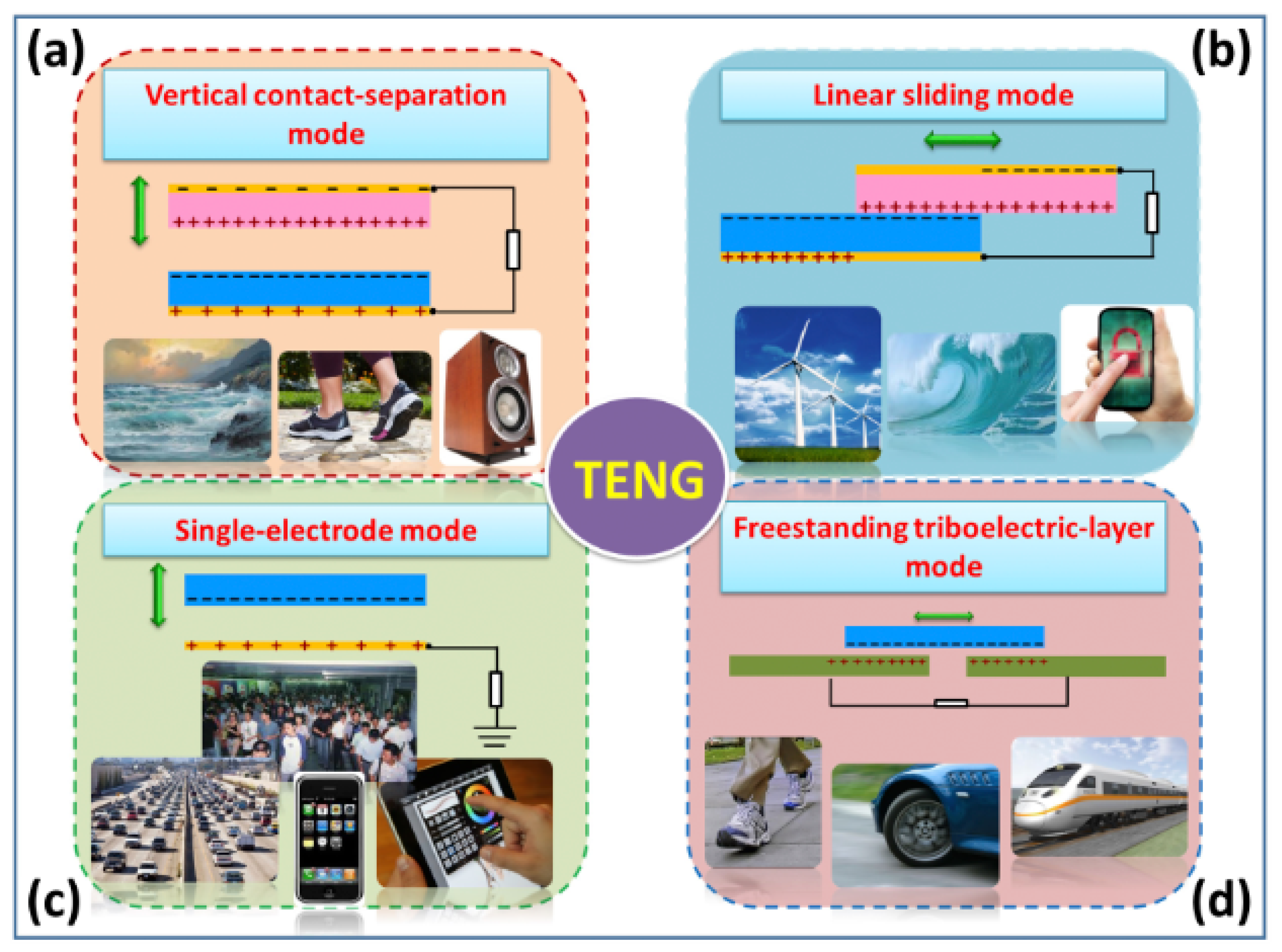
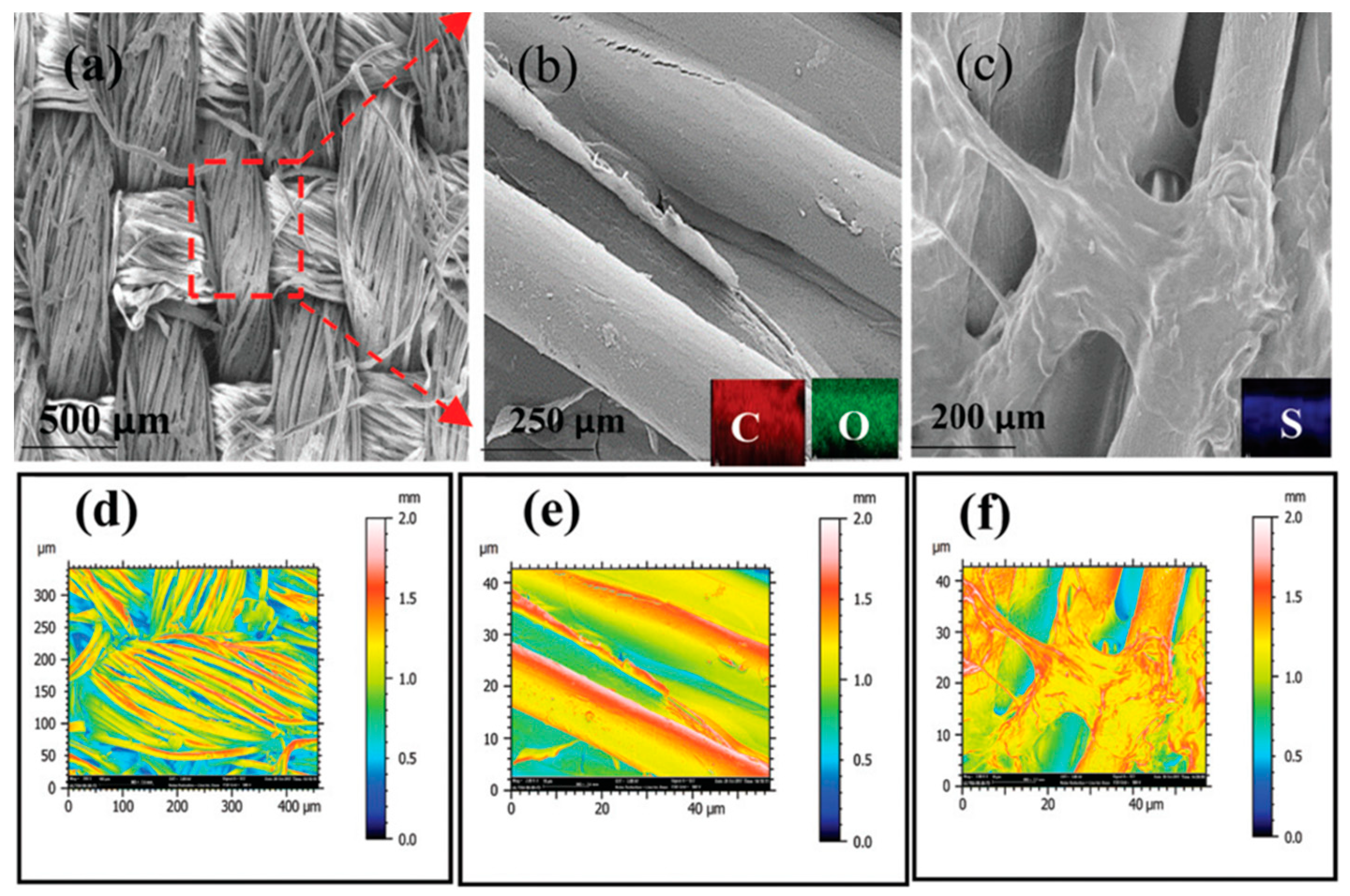
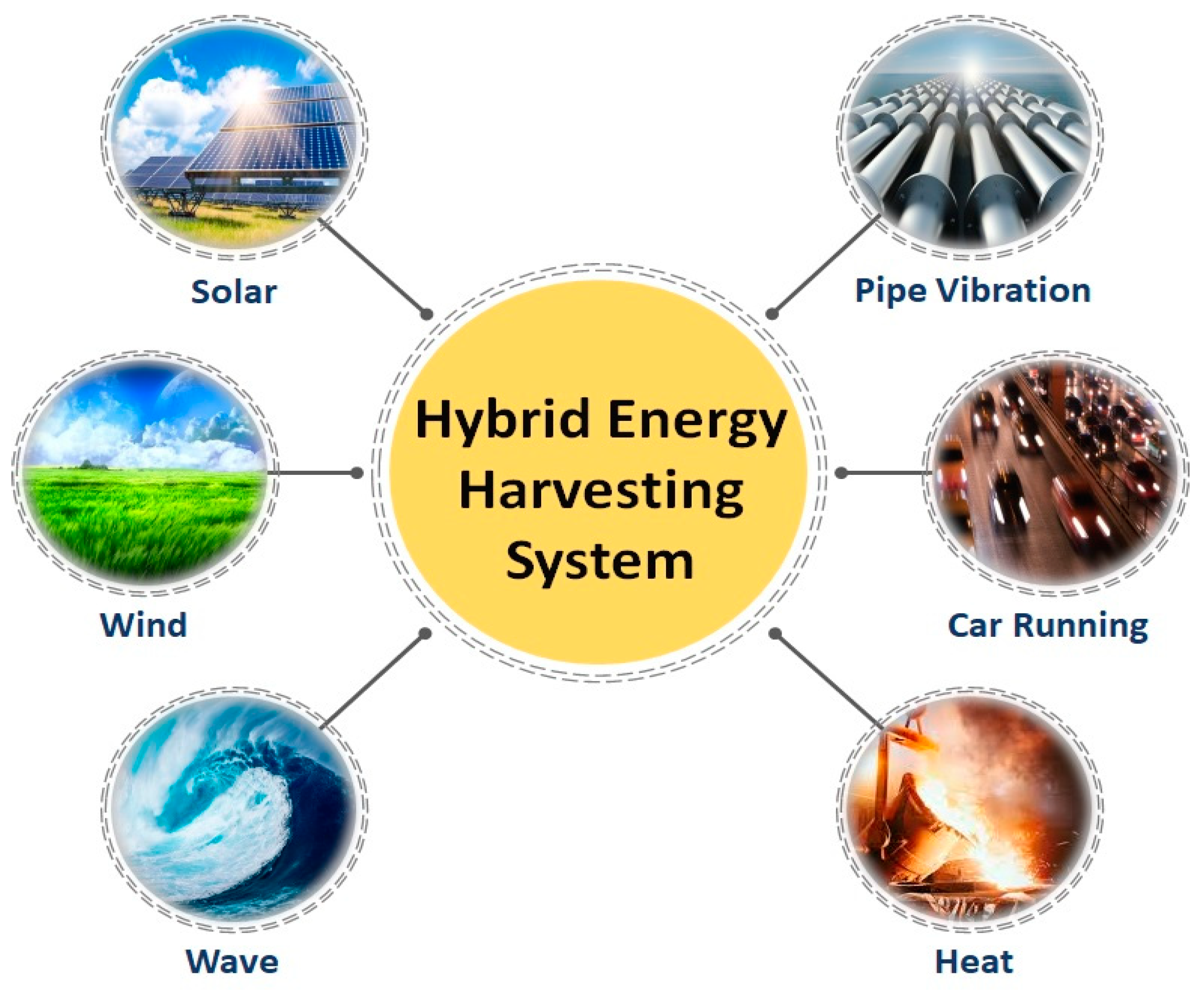
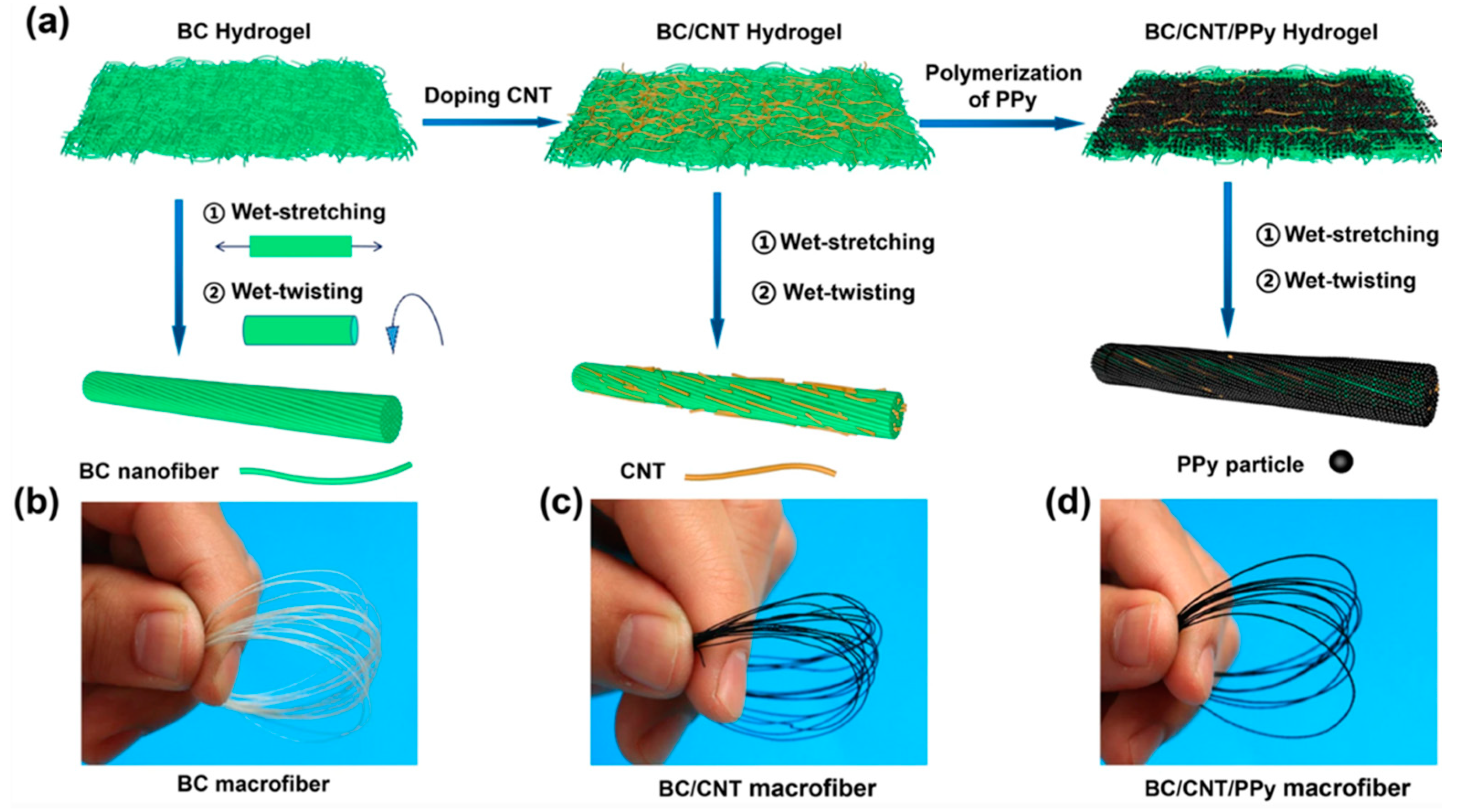
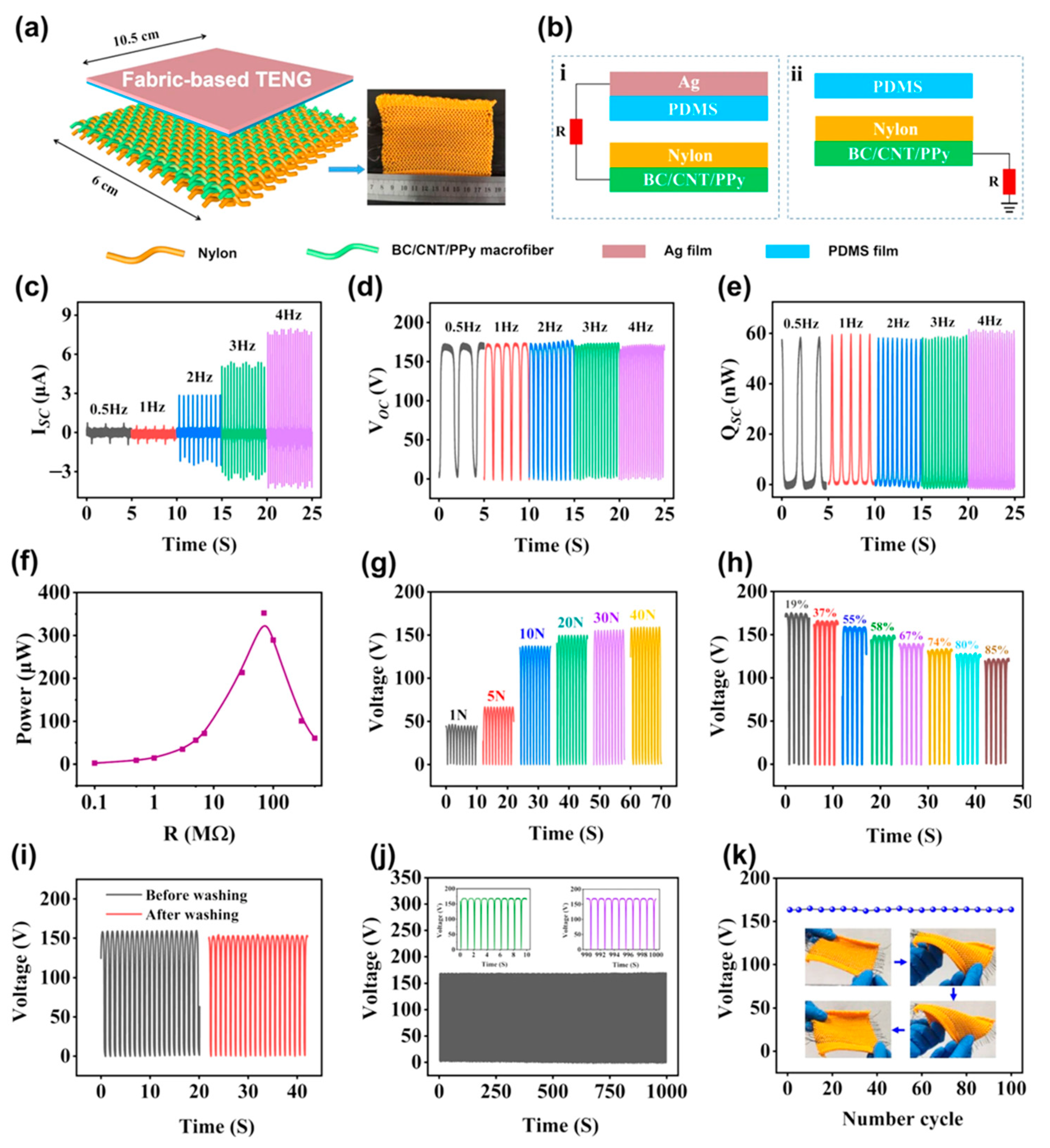
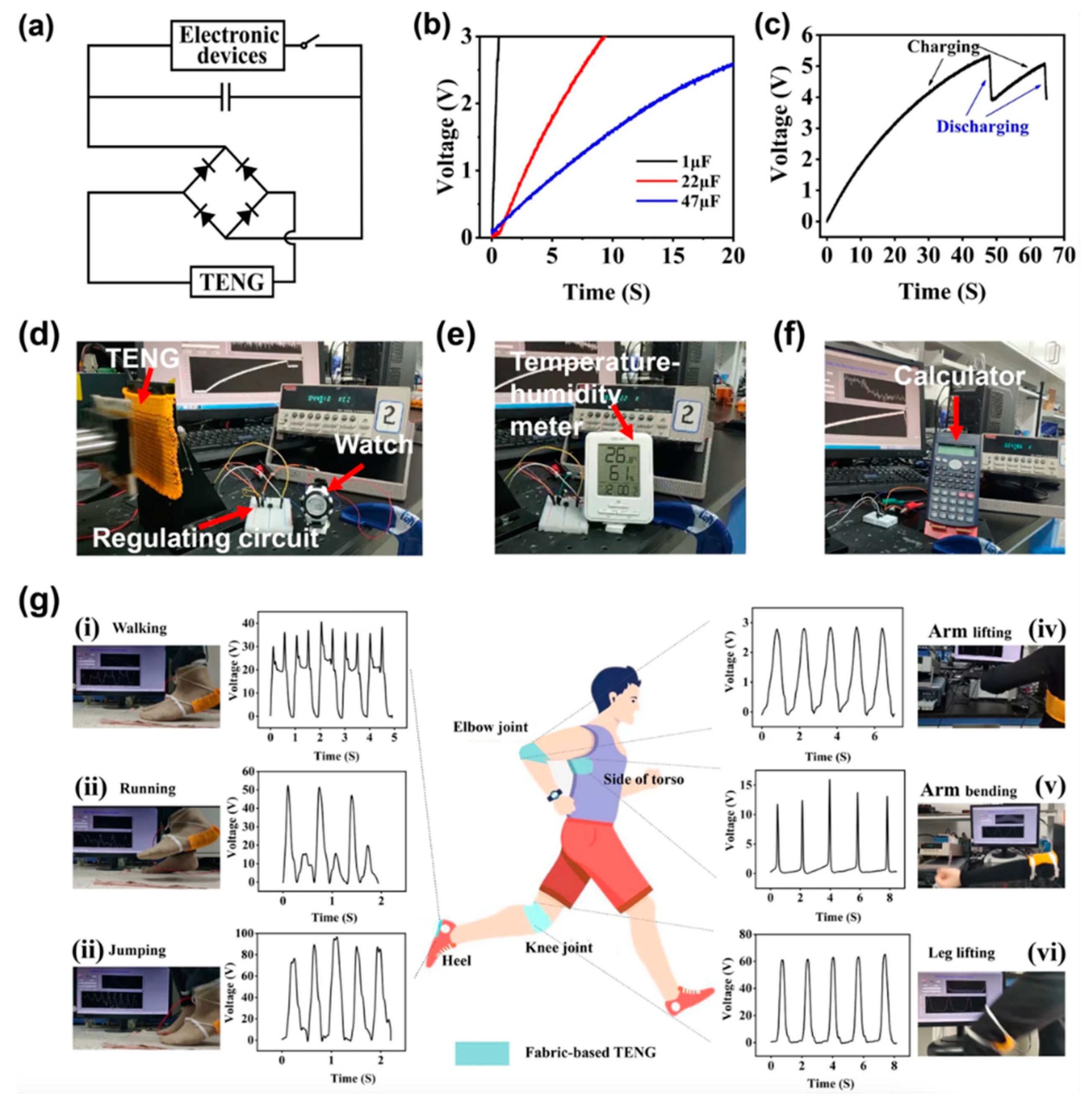
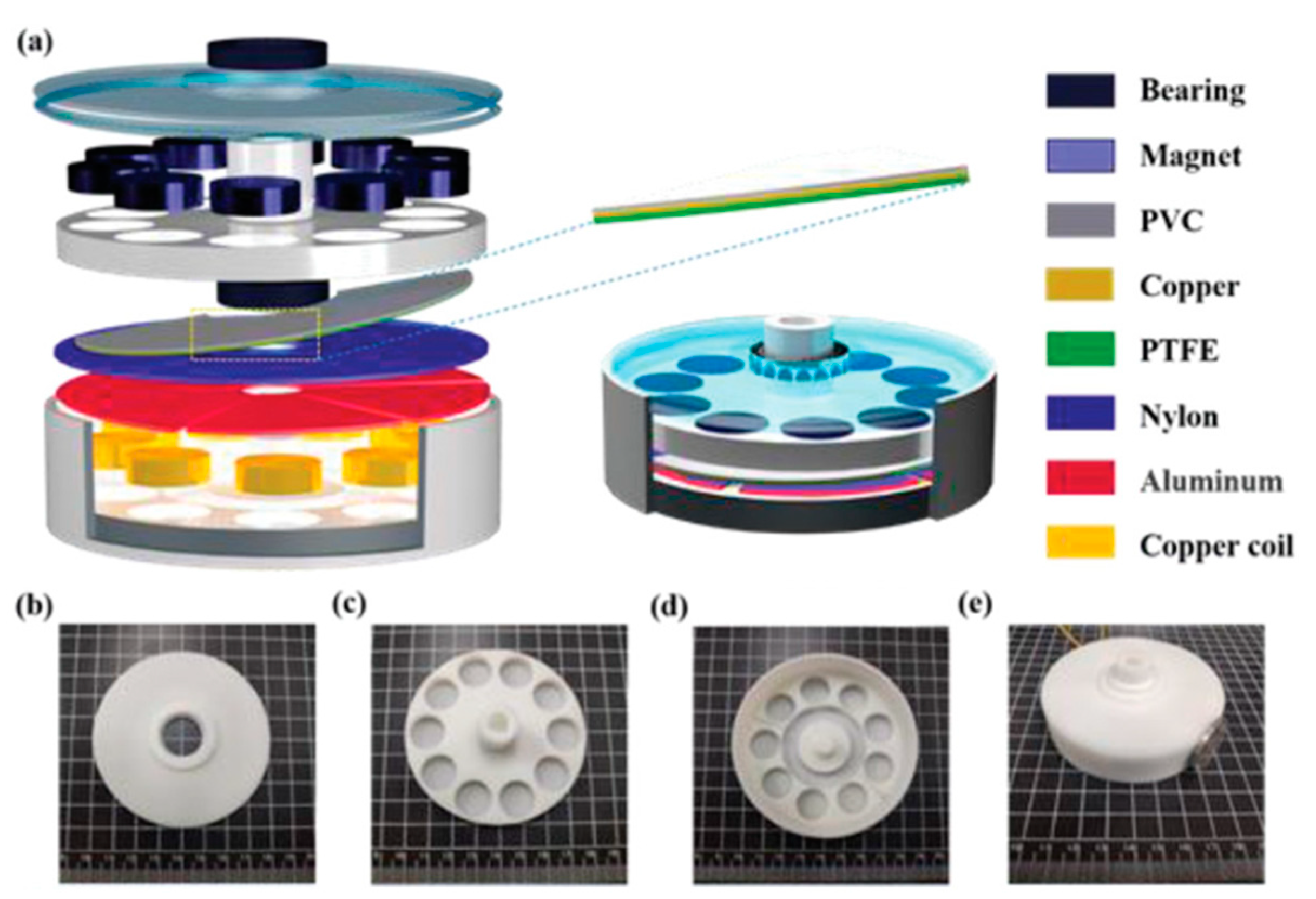

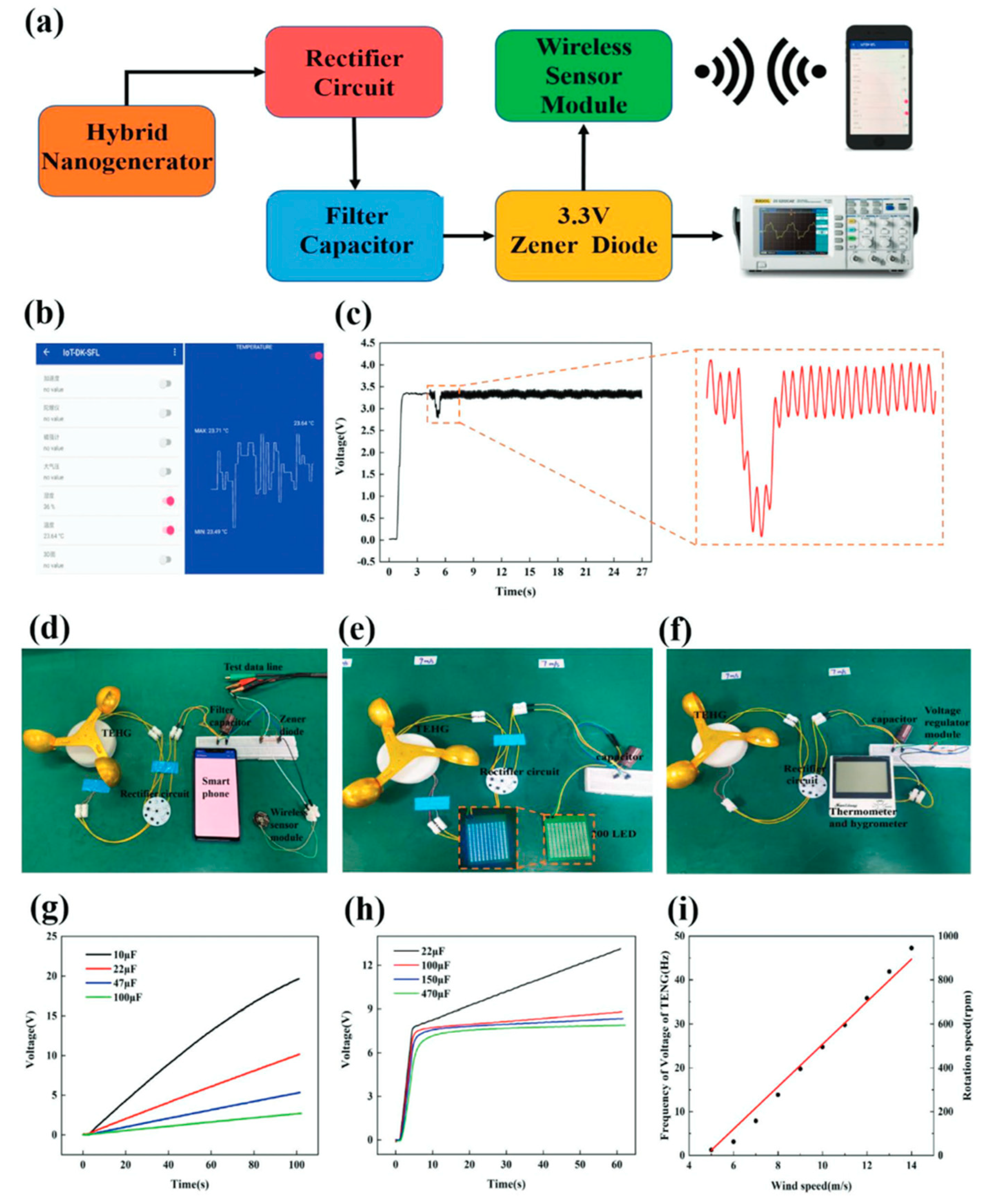

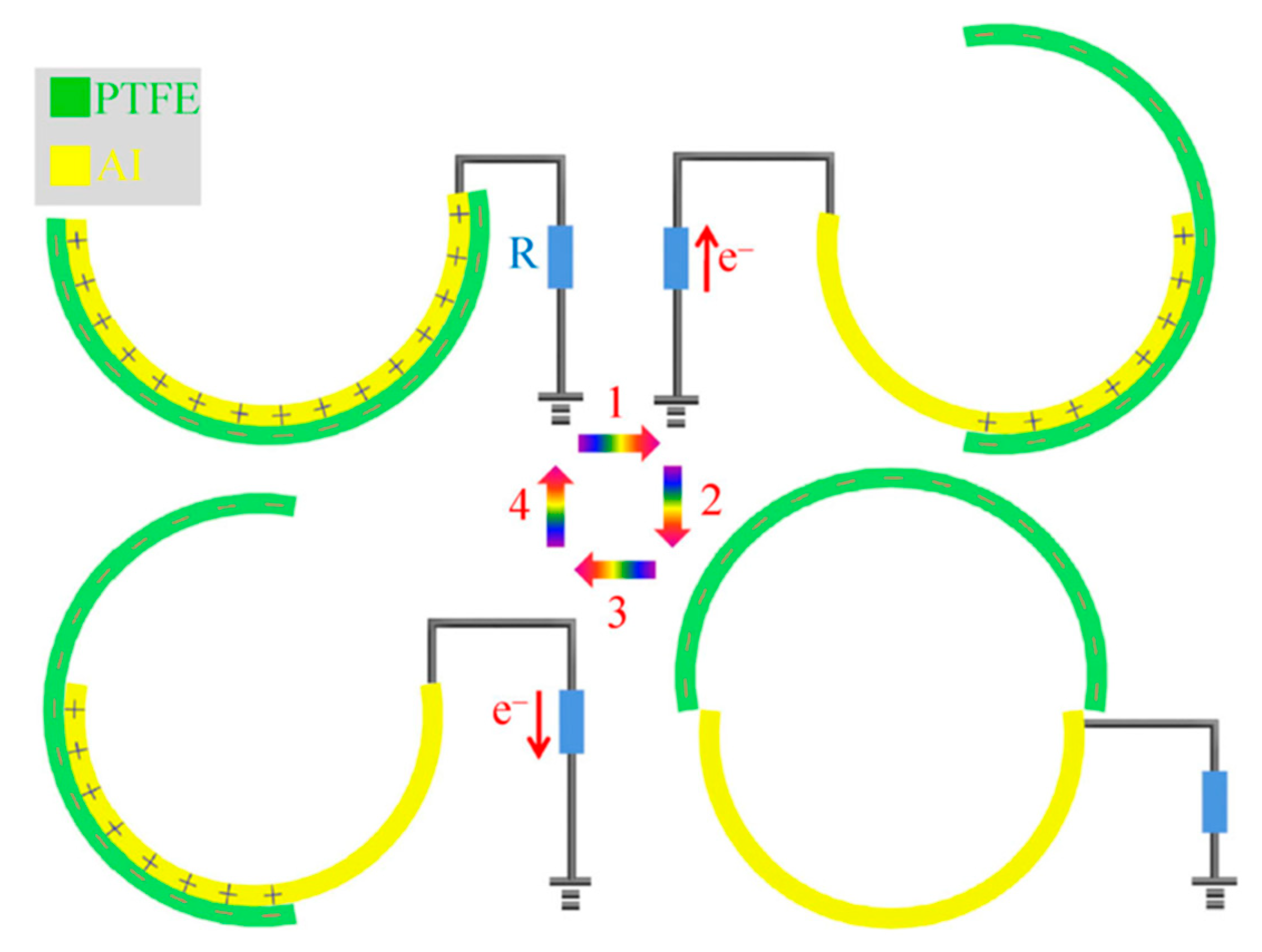

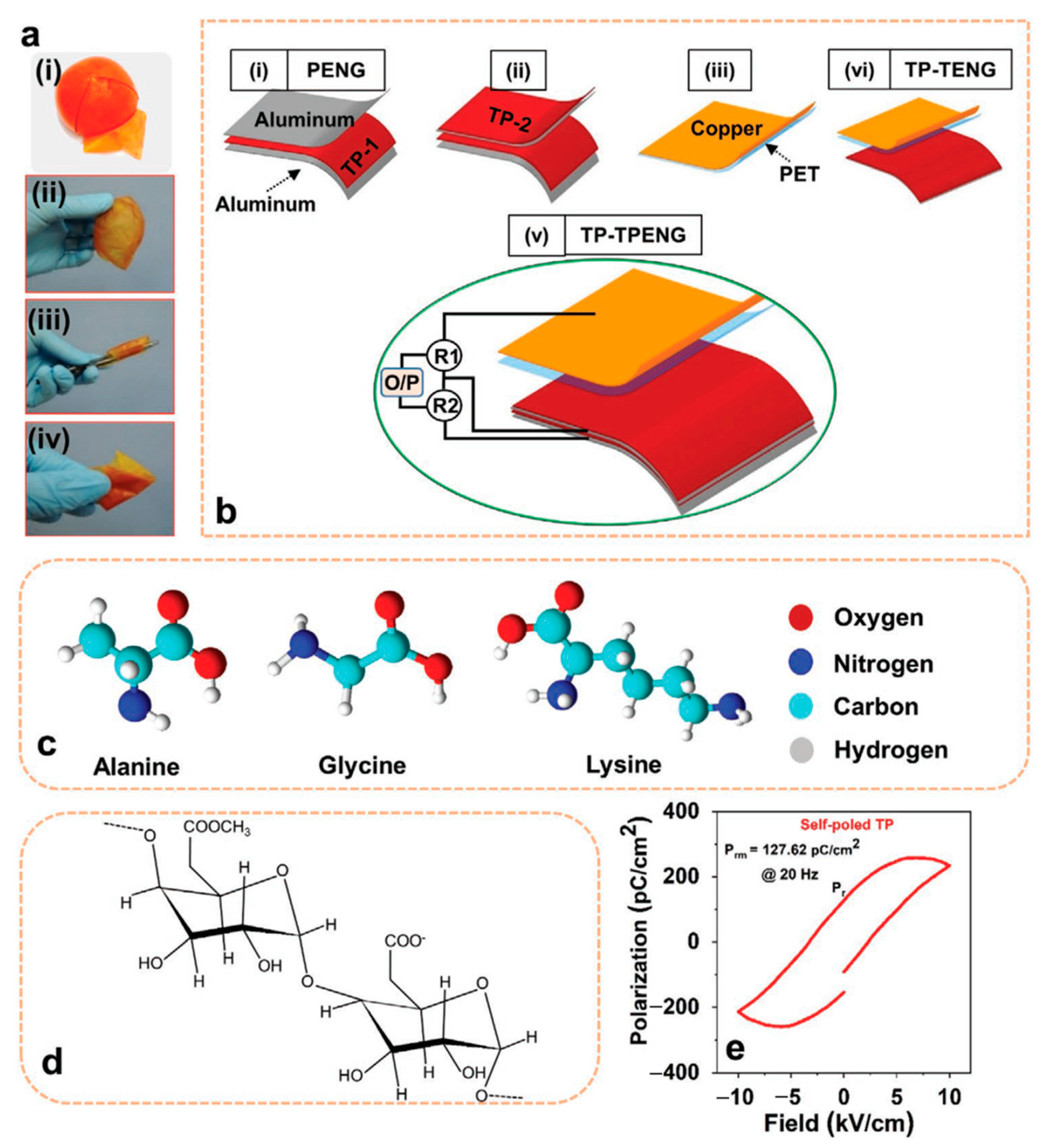
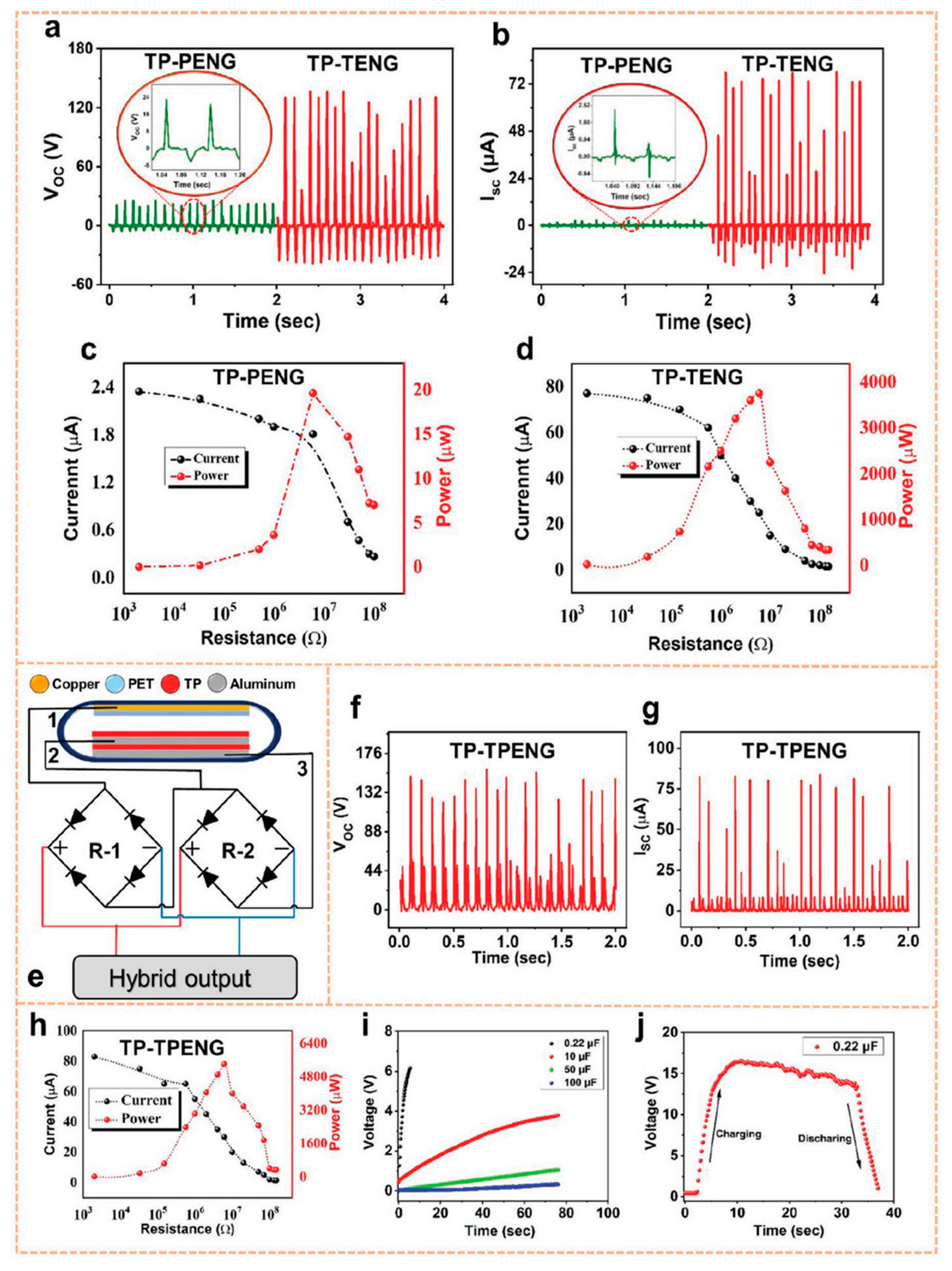
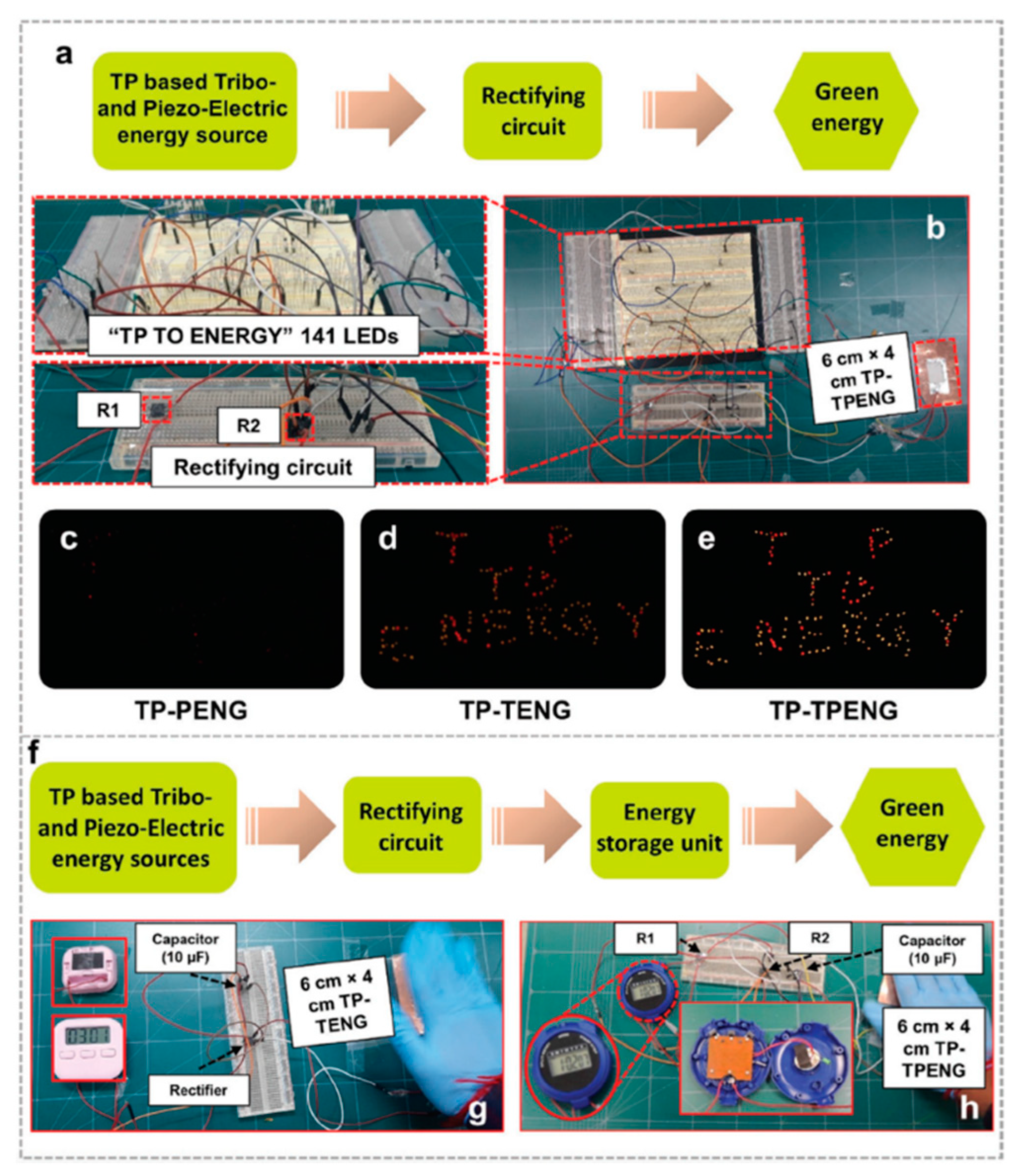

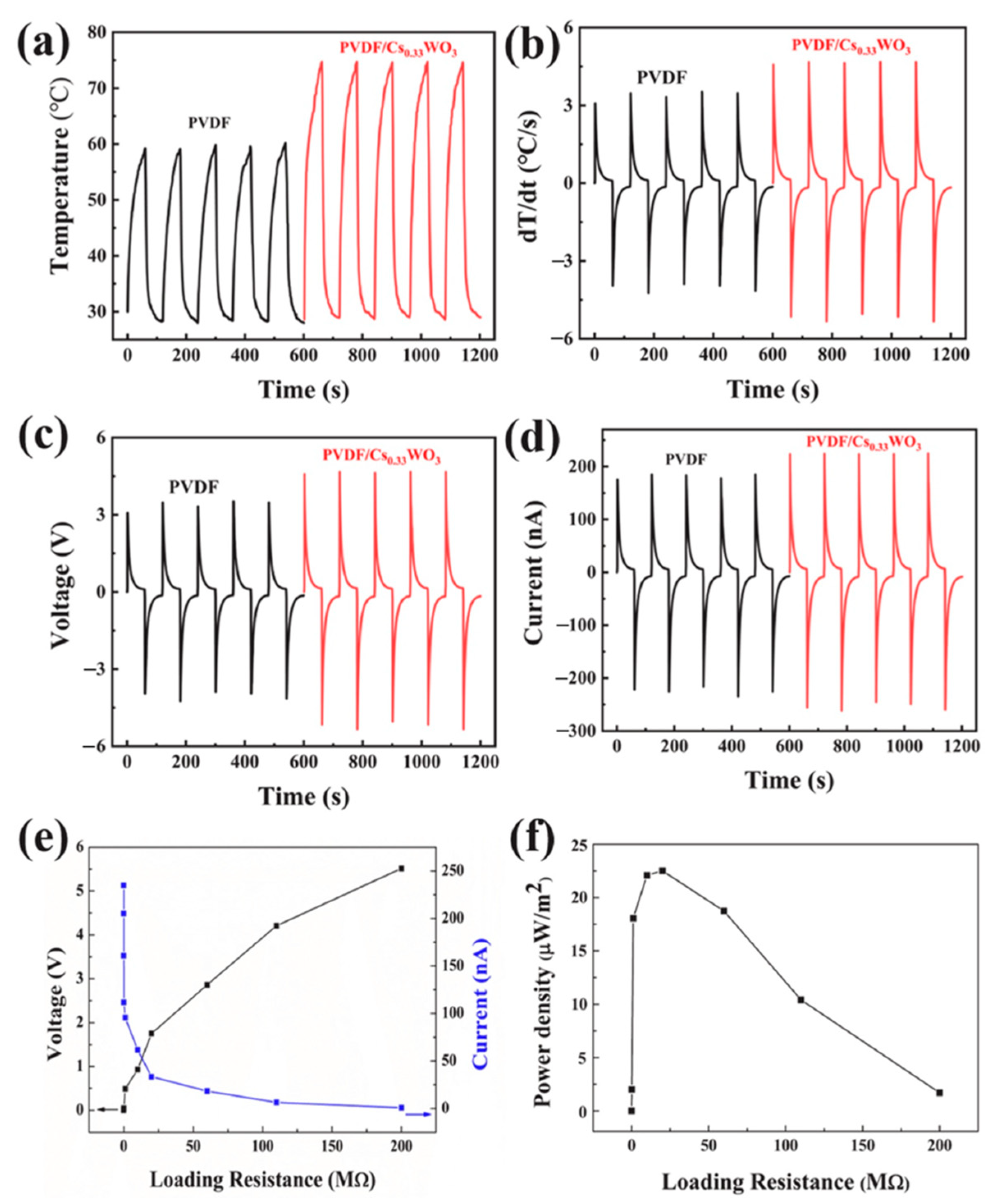
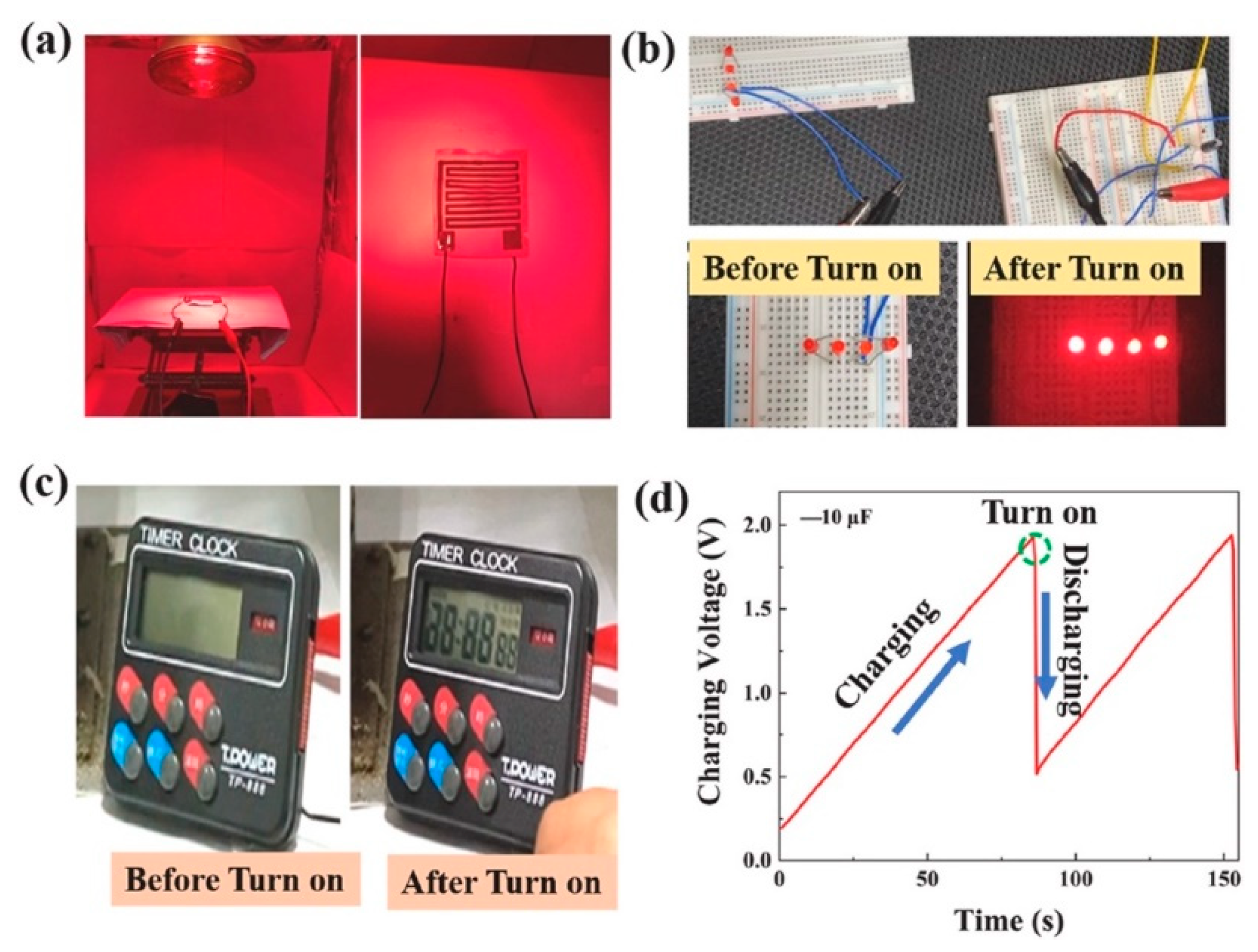
| Transduction Mechanism | Energy Source and Main Materials | Advantages | Weaknesses | Potential Application | Reference |
|---|---|---|---|---|---|
| Piezoelectric | Biomechanical PVDF/Gly-MoS2 composite film | High electro-mechanical performance, large-area compliant, long-time output signal stability, and low-power manufacturing | Performance depends on the Gly-MoS2 nanosheet’s content | Self-powered sensory systems, biomedical monitoring, and wearable electronics | [37] |
| Piezoelectric | Biomechanical PDMS/PPy composite film | Low-cost fabrication and flexible and robust devices | Performance depends on the PPy content | Self-powered biocompatible electronic devices | [38] |
| Piezoelectric | Biomechanical PVDF/coconut husk powder (CHP) composite film | Biowaste materials, simple fabrication process, and good electromechanical stability | Performance power depends on the CHP content | Biomedical devices and sustainable sensors | [39] |
| Piezoelectric | Biomechanical PVDF film | Flexible materials and low-cost fabrication | Electromechanical behavior requires more tests | Self-powered blood pressure sensors and wearable biomedical devices | [42] |
| Piezoelectric | Biomechanical 3D PPy/PVDF-poly-hexafluoropropylene (PHFP) composite film | Flexible materials and good performance stability | Performance depends on the 3D PPy content | Flexible biomedical devices | [44] |
| Triboelectric | Water waves and wind Cu electrodes, deionized water, and fluorinated ethylene–propylene tube | High output power density, simple structure, and easy fabrication process | Output power is highly dependent on the acceleration of water motion | Ship attitude sensors, multi-module devices, and ultra-sensitive sensor systems | [50] |
| Triboelectric | Water waves Stainless steel electrodes and PTFE film | High surface charge density, high output power, and low friction-induced loss | Wear of film by friction | Self-powered marine sensors, ocean buoys, and self-powered distributed energy for the marine IoT | [51] |
| Triboelectric | Water waves Cu electrodes and PTFE balls | Compact structure, ease of integration, and simple operation | Output performance depends on the wave direction and amplitude | Ocean buoys and cost-efficient beacon in night time marine operations | [52] |
| Triboelectric | Water waves Spring steel sheet and PFTE film | High electrical output performance for any direction of movement | Complex structure | Self-powered smart marine sensors and distributed power systems in oceans | [55] |
| Triboelectric | Biomechanical, environmental vibration and wind Ag electrodes, commercial VHB 4905 and Chitin films | Biodegradable materials, simple and cost-efficient fabrication, and high output performance | Performance depends on the chitin concentration | Self-powered flexible sensors, health monitoring of subtle pressures, non-contact sensing, and human–machine interfaces | [64] |
| Triboelectric | Biomechanical Cu electrodes, flourinated ethylene propylene (FEP) film | Simple operation and easy fabrication process | Wear of film by friction | Flexible electronic devices for real-time monitoring of human physiological states | [67] |
| Triboelectric | Biomechanical Cu and Ni fabrics and PDMS with BaTiO3 nanoparticles | Stable electric behavior, ultra-flexibility, mechanical durability, and cyclic washing ability | Complex fabrication | Self-powered, wireless, and intelligent monitoring of human motions, portable power sources, and multifunctional human–machine interfaces | [71] |
| Thermoelectric | Human body heat rGO and PEDOT:PSS-coated textile fabric | Improved thermoelectric efficiency, high flexibility, breathable, washable, and bendable textile fabric | Complex manufacturing process and performance depends on the rGO concentration | Self-powered flexible devices and wearable e-textiles | [78] |
| Thermoelectric | Human body heat Cu, PET, Bi2(Te1−xSex)3, and (BixSb1−x)2Te3 | Good flexibility and high output power density | Complex manufacturing process | Self-powered flexible and wearable sensors | [80] |
| Thermoelectric | Thermal ITO/PET, PEDOT:PSS, and MoS2/graphene composite | Ultra-flexible and shape-adaptive | Complex manufacturing process and performance depends on the MoS2/graphene content | Self-powered temperature sensors | [83] |
| Thermoelectric | Thermal and human body heat PEDOT:PSS/single-walled carbon nanotube (SWCNT) composite fibers | High flexibility and good bending durability | Complex manufacturing process and performance depends on the SWCNT content | Wearable electronic devices | [85] |
| Thermoelectric | Human body heat PDMS/boro nitride, n-Bi2Te3, and p-Sb2Te3 composite films | Portable and good flexibility | Complex manufacturing process | Self-powered wearable sensors for monitoring of human physiological signals and body motions | [90] |
| Pyroelectric | Near-infrared light PVDF/Cs0.33WO3 composite film | High output performance and high charge/discharge stability | Performance depends on the Cs0.33WO3 content | Implantable stimulator, high sensitivity sensors, and self-powered electronic devices | [91] |
| Pyroelectric | Thermal Au and ITO electrodes and ferroelectric antimony sulfoiodide (SbSI)-TiO2 composite film | Simple fabrication process | Performance depends on the size and concentration of the TiO2 nanoparticles | Pyroelectric sensors | [92] |
| Piezoelectric–pyroelectric | Biomechanical MWCNT doped PVDF nanofibers | High electrical output performance and high mechano-sensitivity | Complex manufacturing process and performance depends on the MWCNT content | Biomedical sensors integrated with IoT and remote care of infectious diseases | [96] |
| Piezoelectric–pyroelectric | Biomechanical Graphene oxide (GO), graphene (Gr), and halloysite (HNT) nanofillers and PVDF nanofibers | Improved electrical output performance and thermal stability | Complex manufacturing process and performance depends on the content of GO, Gr, and HNT | Wearable biomedical devices | [97] |
| Triboelectric–piezoelectric | Biomechanical Ag and Cu electrodes, PTFE, Nylon, PVDF films | Self-supported structure, high electrical output performance, low-cost and large-scale fabrication process, and high stability | For low-frequency and low amplitude mechanical vibrations | Self-powered flexible pressure sensors and electronic devices | [31] |
| Triboelectric–piezoelectric | Mechanical vibrations Al electrodes and polyvinylidene fluoridetrifluoroethylene (PVDF-TrFE), barium titanate (BTO), and PDMS composite | Large deformations, low-cost fabrication process, high electrical output performance, and stable electrical behavior | Performance depends on the concentration of PVDF-TrFE and BTO | Self-powered sensors for body motion monitoring, functional keyboards, and self-powered electronic devices placed in vehicles, bicycles, and pavements | [99] |
| Triboelectric–piezoelectric | Biomechanical BTO/silicon rubber (SR) composite film | Large deformation, stretchable, and high electrical output performance | Performance depends on the BTO content | Self-powered sensors for body motion monitoring, e-skin, and flexible wearable electronics | [101] |
| Triboelectric–piezoelectric | Mechanical vibrations Au electrodes, antimony selenoiodide (SbSeI) nanowires, and Kapton film | Simple and cost-effective fabrication process | Low-output power density | Low-power consumption electronic devices | [111] |
| Triboelectric–electromagnetic | Mechanical vibrations Cu foil electrode, polypropylene (PP) film, six magnets and nine coils | Improved electrical output performance | Large volume of magnets and coils | Self-powered flexible gas and motion monitoring, and charge smartphones | [120] |
| Triboelectric–electromagnetic | Wind Cu electrodes, FEP film, two magnets, and four Cu coils | High electrical output performance | Large volume of electromagnetic module | Self-powered electronics devices | [129] |
| Triboelectric–electromagnetic | Mechanical vibrations and biomechanical Al electrodes, BTO/PVDF film, five magnets, and five coils | High electrical output performance | Performance depends on the BTO content | Self-charging power systems for outdoor search and rescue, and electronic devices in the IoT | [27] |
| Triboelectric–piezoelectric–pyroelectric | Mechanical vibrations, wind, and thermal PVDF nanowires-PDMS composite film and ITO electrodes | Highly transparent and flexible | Complex fabrication process | Self-powered electronics | [134] |
| Triboelectric–piezoelectric–electromagnetic | Mechanical vibrations and biomechanical NdFeB magnet array structure, Cu coils, beryllium bronze electrodes, lead zirconate titanate (PZT) sheets, FEP films, and Cu electrodes | Small structure, ultra-low-frequency, multi-stable, portable, and high electrical output performance | Complex assembly of the three nanogenerators modules | Self-powered portable devices for body motion monitoring, sensors for detection of bridge motions, and construction safety monitoring | [142] |
| Triboelectric–piezoelectric–electromagnetic | Wind PVDF/PET film, PTFE film, PVDF film, PET sheet, Al electrodes, and eight NdFeB magnets and six Cu coils | Compact and small structure, and high electrical output performance | Complex assembly of the three nanogenerators modules | Self-powered wireless environmental monitoring system in subway tunnels | [146] |
Publisher’s Note: MDPI stays neutral with regard to jurisdictional claims in published maps and institutional affiliations. |
© 2022 by the authors. Licensee MDPI, Basel, Switzerland. This article is an open access article distributed under the terms and conditions of the Creative Commons Attribution (CC BY) license (https://creativecommons.org/licenses/by/4.0/).
Share and Cite
Delgado-Alvarado, E.; Elvira-Hernández, E.A.; Hernández-Hernández, J.; Huerta-Chua, J.; Vázquez-Leal, H.; Martínez-Castillo, J.; García-Ramírez, P.J.; Herrera-May, A.L. Recent Progress of Nanogenerators for Green Energy Harvesting: Performance, Applications, and Challenges. Nanomaterials 2022, 12, 2549. https://doi.org/10.3390/nano12152549
Delgado-Alvarado E, Elvira-Hernández EA, Hernández-Hernández J, Huerta-Chua J, Vázquez-Leal H, Martínez-Castillo J, García-Ramírez PJ, Herrera-May AL. Recent Progress of Nanogenerators for Green Energy Harvesting: Performance, Applications, and Challenges. Nanomaterials. 2022; 12(15):2549. https://doi.org/10.3390/nano12152549
Chicago/Turabian StyleDelgado-Alvarado, Enrique, Ernesto A. Elvira-Hernández, José Hernández-Hernández, Jesús Huerta-Chua, Héctor Vázquez-Leal, Jaime Martínez-Castillo, Pedro J. García-Ramírez, and Agustín L. Herrera-May. 2022. "Recent Progress of Nanogenerators for Green Energy Harvesting: Performance, Applications, and Challenges" Nanomaterials 12, no. 15: 2549. https://doi.org/10.3390/nano12152549
APA StyleDelgado-Alvarado, E., Elvira-Hernández, E. A., Hernández-Hernández, J., Huerta-Chua, J., Vázquez-Leal, H., Martínez-Castillo, J., García-Ramírez, P. J., & Herrera-May, A. L. (2022). Recent Progress of Nanogenerators for Green Energy Harvesting: Performance, Applications, and Challenges. Nanomaterials, 12(15), 2549. https://doi.org/10.3390/nano12152549










